Text
11 Graphic Design Trends to Watch Out for in 2024

Whether you’re making marketing materials, creating content, or something else entirely, building a successful brand requires a lot of design prowess.
And no matter what it is you’re designing, if you want to ensure you’re making use of all the tools at your disposal, you’ve got to stay up to date on the latest graphic design trends.
For this year, I think it’s safe to say that the dominant trend will be the use of AI in graphic design, and that will likely continue to be the leading trend for several years into the future.
That prediction may sound a bit premature, but if you look at what graphic designers are saying, this couldn’t be any more obvious.
For example, a survey from Adobe, which polled 1,000 creative professionals in the U.S., including graphic designers, found that even by this time last year, many of them were already using generative AI in their work, with 48 per cent saying they’d used ChatGPT, and 34 per cent saying they’d used DALL-E.
What’s more, the vast majority of respondents expected to be using some form of AI in their work in the future, including 69 per cent of graphic designers and illustrators.
Moreover, a survey from Canva, which polled more than 4,000 marketing and creative leaders, including graphic designers, found that 97 per cent of them are comfortable with the rise of generative AI, with 70 per cent saying AI is enhancing their team’s productivity, and 69 per cent saying it’s enhancing creativity.
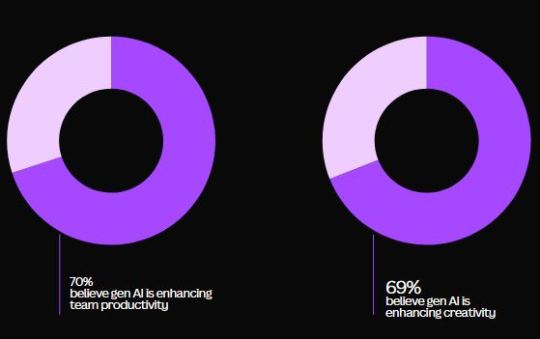
All things considered, it’s clear that the graphic design landscape is rapidly changing, and many of these changes will come as a result of advances in AI.
As someone who helps business owners develop their brands, this trend toward the use of AI in graphic design is incredibly exciting for me, as it offers many unique opportunities to hone your brand positioning.
But while AI will undoubtedly be the most dominant graphic design trend of 2024, it’s by no means the only trend that will be relevant over the coming year.
So, if you want to explore what’s shaping the future of graphic design, and find out which graphic design trends 2024 will be dominated by, then keep reading to learn more.
Read: Looking to Redesign Your Logo? Here’s What You Need to Know

If you’re interested in graphic design trends, then chances are, you might also be thinking about redesigning your logo.
But if you don’t design logos for a living, then it can be difficult to even know where to begin.
With that in mind, this article explains what you need to know to redesign your logo, including both the right reasons to update your logo and the wrong ones.
Keep reading here.
What Are the Latest Graphic Design Trends?
If you want to make sure you’ve got access to all of the best design tools and techniques, you’ve got to follow the latest trends in graphic design.
With that in mind, below I’ve detailed the graphic design trends that I feel will be most important to watch out for in 2024.
1) Artificial Intelligence (AI)
As is the case with most industries today, artificial intelligence (AI) is profoundly transforming the world of graphic design.
AI tools are being used to automate routine tasks, such as resizing images and generating colour palettes, allowing designers to focus more on creative aspects.
Furthermore, AI-driven platforms can analyze user engagement data to suggest design adjustments, making designs not only aesthetically pleasing but also more effective.
And as I mentioned above, for me, one of the most exciting aspects of this technology is how it can be used to benefit your brand positioning.
For instance, AI-powered tools can help refine your brand positioning by ensuring your branding remains consistent across all touchpoints.
However, at this point, there is still a stigma attached to anything created by AI, and people are becoming much better at spotting AI images, so you need to be aware of this and act accordingly.
For instance, if you’re trying to create a life-like or photo-realistic image, it’s going to be pretty obvious that it was made by AI, and a lot of people will not like it.
But in my experience, when it comes to creating imagery, where AI truly shines is in its ability to produce unique and creative images that don’t try to emulate reality.
Still, despite its limitations, and people’s negative perceptions, I think using AI art in graphic design will be one of the biggest design trends of 2024 and years to come.
2) Inclusivity and Accessibility
Designing for inclusivity and accessibility remains a priority in 2024.
When it comes to accessibility, the main focus is on creating content that is accessible to all users, including those with disabilities.
This involves using things like high-contrast colour schemes for better visibility, more legible typography, and considering colour blindness when choosing palettes.
Designers are also emphasizing the representation of diverse populations, incorporating images and themes that reflect a variety of cultures, orientations, and backgrounds, which makes designs feel more welcoming and relatable.
3) Sustainable and Eco-Friendly Design
With the growing awareness of environmental issues like plastic pollution, sustainable design is becoming increasingly relevant.
This push for more sustainable and environmentally friendly design applies to both the materials used in physical products and the digital footprints of online designs.
For instance, designers are minimizing waste by optimizing resources and choosing eco-friendly materials, and in digital spaces, there is a move toward more energy-efficient design practices, such as optimized images for faster loading times, which can help reduce energy consumption while you’re browsing.
4) 3D and Immersive Experiences
The adoption of 3D design continues to expand, fueled by advancements in AR, VR, and mixed-reality technologies, and it’s going to be one of the graphic design trends to watch in 2024.
These tools are bringing new dimensions to traditional flat designs, offering users more interactive and immersive experiences.
From web interfaces to advertising, 3D elements are increasingly being used to create a sense of depth and realism that enhances user engagement and retention.
5) Retro and Vintage
Nostalgia is driving the resurgence of retro and vintage design elements, with an emphasis on late 20th-century styles, which will be trending in 2024 and beyond.
This trend includes things like the revival of pixel art from the ‘90s, vibrant neon colours from the ‘80s, and smooth pastel shades from the ‘70s.
That being said, this year, you’ll see designers combining these old-school influences with modern aesthetics to appeal to both nostalgic older generations and the curiosity of younger audiences.
6) Typography Experimentation
In 2024, typography is not just about readability, but also about personality and expression.
Designers are experimenting with mixed fonts, kinetic typography, and custom typefaces that can enhance brand identity and user interaction.
Moreover, animated text and variable fonts are particularly popular, offering dynamic and responsive design options that adjust to various contexts and devices.
7) Dark Mode and Colour Gradients
Dark mode continues to be a favourite for its aesthetic appeal and reduced eye strain, particularly in low-light environments, and this trend is set to accelerate in 2024.
The popularity of these features has been growing exponentially, not least because they pair so beautifully with vibrant colour gradients that add visual interest and depth.
These gradients can be used in backgrounds, buttons, and overlays, providing a rich interplay of colours that draw the user’s eye and guide them through the design.
8) Data Visualization
As data becomes more integral to decision-making, its presentation is becoming more innovative, and this will continue to be the case throughout 2024.
Designers are creating more interactive and intuitive charts and infographics that allow people to explore and understand complex data with ease.
These visualizations can incorporate animations, clickable elements, and even AR components to make data exploration more beautiful and beneficial.
9) Authentic and Handcrafted
In an era dominated by interactions with AI, authenticity is becoming increasingly sought after.
With that in mind, handcrafted designs that include elements like hand-drawn illustrations or watercolour textures provide a more human touch that digital designs often lack.
These elements help brands stand out by offering a unique and artisanal feel to their visuals, which can resonate more deeply with consumers, and as a result, I think this art style will be one of the graphic design trends to watch this year.
10) Motion and Interactivity
The integration of motion design into web and mobile interfaces is transforming user experiences, and this trend will not be slowing down in 2024.
Throughout this year, you’re going to see more and more designers using these dynamic elements, as they’re crucial for guiding users, providing feedback, and adding a layer of depth to the digital experience.
The popularity of things like subtle animations, interactive elements, and smooth transitions will only continue to grow this year, as they can enhance the usability of interfaces, making interactions feel more natural and engaging.
11) Minimalism and Maximalism
Both minimalism and maximalism find their places in 2024’s graphic design landscape.
Minimalism appeals through its clarity and simplicity, making it ideal for conveying clear messages and improving user experiences.
On the other hand, maximalism embraces excess and complexity, offering rich, vibrant, and detailed designs that capture attention and evoke emotional responses.
But regardless of which one you prefer, you can expect to see more use of these art styles in 2024 and far into the future.
Want to create or redesign a logo, but don’t know where to begin? Why not set up a free 30-minute consultation with me to find out what we can do for you?
To your business success,
Susan Friesen
0 notes
Text
What’s the Difference Between a Tagline and a Slogan?

If you don’t build brands for a living, you may be under the impression that there’s no difference between a tagline and a slogan.
After all, they are somewhat similar, and the terms tagline and slogan tend to be used interchangeably.
If you were to go back several years and ask me this question, even I might not have known how to explain the difference.
But as I’ve found out over more than 20 years of helping business owners build their brands, there is a significant difference between a tagline and a slogan.
What’s more, I’ve learned that to create the best tagline and/or slogan for your business, and ensure you’re using these elements to their fullest potential, it’s important to understand the differences between them.
So, if you’re interested in using taglines and slogans in branding, and want to know the best practices for writing a slogan or tagline, how these elements can benefit your business, and how they differ, then keep reading to learn more.
Read: Crafting a Unique Selling Proposition: Unleashing the Power of Your Brand

Your unique selling proposition (USP) is incredibly important for the creation of slogans and taglines, as it helps you to communicate why consumers should choose to do business with you instead of your competitors.
With that in mind, if you want to come up with an effective tagline or slogan, first you’ve got to define what’s unique about your brand.
This article explains everything you need to know to craft a USP, including what a USP is, the benefits of having one, and how you can create one of your own.
Keep reading here.
How Can Taglines and Slogans Benefit My Business?
If you want to know the difference between a tagline and a slogan, you’re probably already thinking about using them.
But you might be on the fence about how beneficial these elements actually are and wondering if creating them is even worth your time.
That being said, here’s how the use of taglines and slogans can benefit your business:
Brand Identity and Recognition
Taglines and slogans are a key part of developing a memorable brand identity.
A catchy, unique phrase can become synonymous with your brand, embedding it in the minds of consumers.
For instance, Nike’s “Just Do It” encapsulates a spirit of determination and resilience that is instantly recognizable.
This association helps enhance brand recognition, making it easier for customers to remember and choose your brand over competitors.
Cost-Effectiveness
The repeated use of taglines and slogans, across various branding and marketing materials, can provide ongoing benefits without the need for significant further investment.
This makes the use of slogans and taglines a conspicuously cost-effective component of your branding and marketing strategies.
Communicate Your Core Values and Benefits
A well-crafted tagline swiftly and effectively communicates the essence of your company’s unique selling proposition, highlighting what your brand stands for and/or the key benefits it offers.
For example, BMW’s tagline, “The Ultimate Driving Machine”, communicates quality and a superior experience, helping potential customers understand what sets this brand apart from others in just a few words.
Keep Things Consistent
Taglines and slogans can amplify marketing campaigns by ensuring a consistent message across all platforms.
Whether it’s in print, online, or broadcast form, a strong slogan reiterates the same message, reinforcing your brand’s presence and message.
This repetition makes marketing campaigns more effective as the consistency helps solidify consumers’ understanding and recognition of your brand.
Create an Emotional Connection
Slogans can evoke emotions and create a personal connection with your audience, and by appealing to feelings, slogans can make your brand feel more relatable and approachable.
For example, Hallmark’s “When You Care Enough to Send the Very Best” touches on the sentimentality of giving, which resonates deeply with consumers who want to convey affection through cards and gifts.
Differentiate Your Brand From Competitors
Having a distinctive slogan or tagline can set your brand apart from its rivals, and this is especially true in more competitive markets.
The uniqueness of a catchy slogan can be a significant differentiator, highlighting a unique selling proposition or brand philosophy that competitors do not offer.
This differentiation is crucial in crowded markets where unique features and benefits might be similar across products or services.
Make Your Brand More Memorable
Taglines and slogans are typically short, memorable, and easy to share, making them effective for word-of-mouth marketing.
And because they’re simple to remember, customers can easily mention them in conversations, which can help enhance your brand visibility and organic reach, significantly boosting your marketing efforts without additional costs.
Gain Greater Loyalty
A strong slogan or tagline can foster brand loyalty by continually reinforcing your brand’s image and message to existing customers.
This serves as a constant reminder of why they chose your brand in the first place, which can help to encourage repeat business.
For example, Apple’s “Think Different” tagline encourages loyalty among users who see themselves as creative and innovative, as their values align with the brand’s emphasis on creativity in its products.
Stay Flexible
Slogans and taglines are highly adaptable and can be used across various media and advertising platforms, from TV spots and radio to online ads and social media.
This flexibility allows you to maintain a cohesive branding strategy across all marketing channels, maximizing your reach and the impact you have on your audience.
What’s the Difference Between a Tagline and a Slogan?
The difference between a tagline and a slogan may seem like an incredibly granular thing to discuss, but if you own a business, it’s important to understand the distinction.
Having said that, I should start by pointing out that the main difference between the two is how they’re used.
In a nutshell, taglines are used more for brand positioning, and slogans tend to be used for marketing campaigns.
A tagline will help to position your brand by associating it with the value of your offerings and what differentiates you from the competition, whereas a slogan is used to communicate the ideas of a specific marketing campaign.
But it’s not necessarily that cut and dried, and there’s still some overlap.
For instance, Nike’s famous tagline, “Just Do It”, which I mentioned above, was developed as part of the company’s first major TV advertising campaign, but it quickly became so popular that Nike started using it as a tagline, and it’s still their tagline to this day.
So, as you can see, taglines and slogans do have some similarities, but if you want to use them to their fullest potential, it’s important to understand their purpose and the differences between them.
With that in mind, here are the key differences between a tagline and a slogan:
Definition and Purpose
Taglines are permanent phrases associated with your company as a whole, and they’re designed to be timeless and typically do not change very often.
They reflect your brand’s identity, values, and overarching promise to customers, and their primary purpose is to enhance brand recognition and encapsulate the essence of your brand in a way that resonates emotionally with consumers.
Slogans, on the other hand, are more flexible and are typically used for a particular marketing campaign or a specific product or service.
They aim to highlight features, benefits, or the uniqueness of what’s being advertised, and they may change frequently to align with different marketing initiatives.
Duration and Usage
Taglines are long-term and remain consistent across all marketing and branding materials.
And because they’re intended to last, taglines help maintain a consistent brand message over time.
A well-known example is Disneyland’s “The Happiest Place on Earth”, which consistently reinforces the brand’s association with joy and magical experiences.
Slogans are short-term tactical tools used to draw attention to specific aspects of a product or highlight a promotion, and they often vary depending on your current marketing goals or target audience.
For instance, McDonald’s has used various slogans like “I’m Lovin’ It” as a tagline, but also campaign-specific slogans like “The Simpler the Better” for their advertising.
Emotional vs. Rational Appeal
Taglines often aim to create an emotional appeal and are crafted to resonate on a deeper level, building a connection between your brand and consumers that transcends the features of specific products or services.
This emotional resonance helps build brand loyalty and long-term customer relationships.
Slogans, on the other hand, tend to be more rational or directly informative, focusing on the practical benefits or features of a product, service, or promotion.
They are designed to be persuasive and drive immediate consumer actions, such as purchases or inquiries, and they’re often surprisingly straightforward, making them effective for conveying specific sales messages.
Branding vs. Advertising
Taglines are a core component of branding, as they help form the public perception of your brand and are integral to your brand’s voice and personality.
They’re something customers will remember even when they aren’t actively thinking about making a purchase.
Slogans, on the contrary, are primarily used in advertising and are crafted to be catchy and memorable for the duration of a campaign, aiming to maximize impact in a shorter timeframe.
They support specific marketing objectives and are often geared toward generating sales or promoting awareness of a new product.
Strategic Implications
The strategic use of taglines involves embedding them into the fabric of your brand.
That means every interaction with your target audience should reinforce the message conveyed by the tagline, thereby solidifying your brand positioning and emotional appeal.
For slogans, the strategy revolves around flexibility and adaptability, utilizing different messages to highlight specific aspects of a product and/or service, as needed.
This adaptability allows you to respond quickly and effectively to changing market conditions and consumer preferences.
Need help crafting effective taglines or slogans? Why not set up a free 30-minute consultation with me to find out what we can do for you?
To your business success,
Susan Friesen
0 notes
Text
What You Can Do to Create an Online Store People Trust

If you own an online store, you’ve probably worked really hard to get everything up and running.
But if you want to continue to reap the rewards of that hard work, and keep your store going long into the future, you have to create an online store people trust.
Because regardless of how good your offerings are, if you’re not seen as trustworthy, it’s going to be difficult to convince anyone to do business with you.
Luckily, there’s evidence to show that consumers already have a considerable amount of trust in eCommerce.
In fact, in a survey from Chubb, most consumers said they trust companies’ digital storefronts.

But even though most consumers seem to have trust in eCommerce stores, digital storefronts and eCommerce platforms are still at the bottom of this list.
That being said, some consumers will still be on the fence about whether or not they can trust you, no matter what kind of eCommerce shop you run, so you need to do whatever you can to show them your store can be trusted.
Looking at things from a demographic perspective, it’s also important to note that 18-26-year-olds seem to have the lowest trust in eCommerce and digital storefronts, while nearly 90 per cent of them have trust in social media shopping.
What’s more, those 59-68 years of age appear to have no trust in social media shopping and believe it or not, their most trusted place for shopping is actually digital storefronts, as opposed to brick-and-mortar.

I wanted to draw attention to this because if you want to create an online store people trust, then you’ve got to consider the needs, wants, and expectations of your target market and ensure you’re selling on the right platform(s).
But regardless of your target market’s age, or where they choose to shop, there’s a lot you can do to gain customer trust in eCommerce.
So, if you’re looking to build a trustworthy online store, then this is an article you’re not going to want to miss.
Read: Our Top 10 Tips to Enhance Your Online Store and Increase eCommerce Sales

If you want to boost online sales, it’s going to require a heck of a lot more than trust.
From optimizing your website and enhancing the user experience to leveraging technology and tools, if you want to increase eCommerce sales, you’ve got to offer consumers the best possible experience.
With that in mind, this article offers our top 10 tips on what you can do to improve your eCommerce store and sell more online.
Keep reading here.
How to Create an Online Store People Trust
Trust forms the bedrock of any successful business venture, and this is especially true in an online environment where customers often hesitate to divulge personal and financial information.
So, if you want to create an online store people trust, you’re going to need a multifaceted approach that encompasses various elements, including everything from website aesthetics to customer service and security protocols.
Here’s what you can do to craft an online store that instills confidence in your visitors and fosters long-term trust:
Professional Website Design
A professionally designed website is akin to a well-tailored suit – it exudes confidence, competence, and professionalism.
Having said that, you should invest in a visually appealing layout for your website that reflects your brand’s identity while prioritizing user experience.
Among other things, this requires a clutter-free interface with intuitive navigation, clear categories, and easy-to-find product listings.
Secure Payment Gateway
Another crucial aspect of creating a trustworthy online store is ensuring you’re using a secure payment gateway, as customers must feel assured that their information is safeguarded against potential threats.
So, make sure to partner with a reputable payment gateway provider to make sure you’re able to process transactions securely.
You should also implement Secure Sockets Layer (SSL) encryption to encrypt data transmitted between the customer’s browser and your server, which further enhances the security of online transactions.
Transparent Pricing and Policies
Transparency breeds trust, so make sure to display product prices, shipping fees, and any additional charges upfront to prevent unpleasant surprises during checkout.
In addition, you should make sure to clearly articulate your return, refund, and exchange policies, so you can set clear expectations for customers and alleviate any concerns they may have about post-purchase support.
High-Quality Product Images and Descriptions
Visual appeal plays a pivotal role in online shopping, and this is also true if you want to create an online store people trust.
People don’t want to see dark, blurry, out-of-focus, or pixelated photos, or products with descriptions that are missing pertinent information, as this makes it harder for them to make a purchase decision and also makes it look like you’re running a Mickey Mouse operation.
So, make sure to provide high-resolution images of your products from multiple angles to offer customers a comprehensive view, and you should accompany those product images with detailed descriptions that include things like key features, dimensions, and materials used.
Customer Reviews and Testimonials
Whenever you can, you should leverage the power of social proof by prominently showcasing customer reviews and testimonials on your product pages.
Genuine feedback from satisfied customers serves as a testament to the quality and reliability of your offerings and this can significantly boost consumers’ trust in your online store.
Moreover, you should make sure to encourage customers to leave reviews and ratings after making a purchase, and you should also promptly address any negative feedback to demonstrate your commitment to customer satisfaction and continuous improvement.
Contact Information and Support
Accessibility breeds confidence, so you should do whatever you can to make it effortless for customers to reach out to you.
This includes prominently displaying contact information, including email addresses, phone numbers, and physical addresses, if applicable.
You should also offer multiple channels for customer support, such as live chat, email correspondence, and telephone assistance, as timely and helpful responses to inquiries can help instill trust and foster positive relationships with customers.
Get in Front of the Right Audience
Getting in front of the right audience by making use of things like podcasts can significantly enhance trust in your online store, so long as you say the right things.
Podcasts, in particular, offer a unique opportunity to connect with potential customers on a personal level, allowing you to share your knowledge, showcase your products, and engage in authentic conversations.
This gives you the ability to position yourself as a knowledgeable authority and establish trust by demonstrating your expertise and fostering genuine connections with your target audience.
Trust Badges and Security Seals
Another great way to inspire trust in your online store is to display trust badges and security seals from renowned third-party organizations, such as SSL certificates and payment processor logos, as this can help reassure consumers about the integrity of your website.
These visual cues serve as tangible evidence of your commitment to safeguarding customer data and mitigating online security risks.
Mobile Optimization
It seems that everyone and their dog has a smartphone today, and as a result, optimizing your online store for mobile users is imperative.
Having said that, you’ve got to ensure that your website is responsive, which means that it seamlessly adapts to various screen sizes and resolutions.
Mobile optimization enhances the user experience, keeps people on your site for longer, and builds trust by showing that you understand the needs of modern consumers.
Social Proof and Social Media Presence
Cultivating a robust social media presence across relevant platforms can help you engage with your audience, amplify your brand’s visibility, and in turn, build trust.
One great way to do this is by showcasing user-generated content, such as customer photos and testimonials, to provide tangible evidence of the quality and popularity of your products.
These kinds of authentic interactions on social media platforms can help foster a sense of community and trust among your audience.
Secure and Streamlined Checkout Process
Shopping cart abandonment is one of the biggest issues for eCommerce stores, and this often happens because the checkout process seems insecure or is too convoluted.
That being said, you should do whatever you can to streamline your checkout process to minimize friction and facilitate seamless transactions.
For instance, implementing user-friendly features such as guest checkout options and saved payment information can help expedite the purchasing process.
What’s more, you should employ stringent security measures, such as CAPTCHA verification and address validation, to help mitigate fraudulent activities and safeguard customer data during online transactions.
Clear Privacy Policy
Transparency regarding data privacy is paramount if you want to create an online store people trust, as this instills confidence and reinforces your commitment to ethical business practices.
With that in mind, you should publish a comprehensive privacy policy that fully explains how you collect, utilize, and protect customers’ information.
Within this privacy policy, you should assure customers that their data will be handled with the utmost confidentiality and will not be shared with third parties without explicit consent.
Consistent and Distinctive Brand Identity
Establishing a distinctive brand identity is pivotal if you want to build trust in your online store.
This involves crafting a compelling brand narrative that resonates with your target audience and reflects your core values.
You should also make a point of consistently reinforcing your brand identity across all touchpoints, including your website, product packaging, and marketing efforts, as a cohesive brand presence fosters familiarity and trust in consumers.
Fast and Reliable Shipping
Timely delivery is a hallmark of exceptional customer service.
Having said that, you should offer expedited shipping options to cater to customers with urgent needs, while also providing standard shipping methods for cost-conscious shoppers.
In addition, make sure to provide shipment tracking information to keep customers informed about the status of their orders and alleviate any anxiety over delivery timelines.
This kind of transparent communication regarding shipping updates helps to enhance trust and fosters a positive post-purchase experience.
Hassle-Free Returns and Exchanges
A hassle-free policy for returns and exchanges signals confidence in the quality of your products and builds trust with your audience.
So, you should do whatever you can to simplify your return and exchange process to reassure customers and alleviate concerns about potential buyer’s remorse.
In any case, make sure to clearly articulate your return policy, including any eligibility criteria and associated procedures.
You can also offer free returns or exchanges whenever feasible to incentivize purchases and mitigate perceived risks for potential customers.
Continuous Improvement and Feedback
Another thing you can do to create an online store people trust is embrace a culture of continuous improvement by asking your customers for feedback through things like surveys and reviews.
These insights can help you identify areas for improvement across various aspects of your online store, including product offerings, website functionality, and customer service practices.
Moreover, demonstrating responsiveness to customer feedback underscores your commitment to delivering exceptional experiences, which helps foster trust and loyalty.
Looking to create an online store people trust? Why not set up a free 30-minute consultation with me to find out what we can do for you?
To your business success,
Susan Friesen
P.S. If you liked the article, you might want to subscribe to our newsletter. We publish tons of valuable content to help you learn more about marketing, and subscribing is the best way to ensure you don’t miss out. Additionally, if you’d like to learn more about building a search engine optimized website, click here for our free website guide.
#online shopping experience#build an online store#ecommerce strategy#ecommerce websites you can trust#online store website
0 notes
Text
Our Top 10 Tips to Enhance Your Online Store and Increase eCommerce Sales

Now that your online store is finally up and running, you’re probably excited beyond belief.
It may have taken months, if not years, to get to where you are today, and you’re likely anxious to start shipping orders to your customers.
But regardless of how exciting this can be, if you’re struggling to stay afloat, and you need to increase eCommerce sales just to keep your head above water, it can be incredibly devastating.
That being said, you can take comfort in the fact that eCommerce challenges are very common, not just for small businesses, but even for large corporations that are making hundreds of millions of dollars.
For example, a survey from Zoovu, which polled hundreds of executives from companies with a minimum of $200 million in eCommerce revenue, found that two-thirds of them “believe online commerce is broken” before citing a long list of issues.
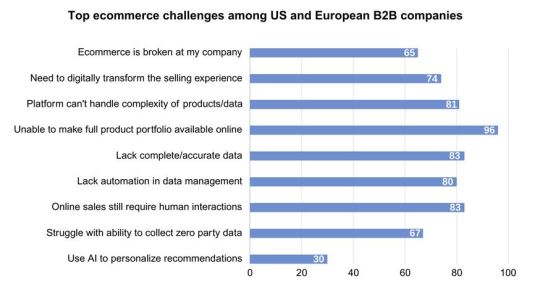
Unsurprisingly, the majority of executives polled said they’re dealing with nearly all of the eCommerce challenges listed above, including things like how to provide more personalized recommendations, how to adapt the selling experience digitally, and a range of data-related issues.
What’s more, they detailed several other problems, including things like frustrated customers, low conversion rates, and lost revenue.
As you can see, eCommerce challenges are quite common, regardless of how big your business is, and even large corporations are looking for ways to improve their online stores and increase eCommerce sales.
Luckily, there’s a lot you can do to improve your online store, and even a few simple changes can help to significantly improve eCommerce sales.
So, if you’re looking for eCommerce optimization tips and want to find out how to increase online sales, then keep reading to learn more.
Read: How Cross-Selling Boosts eCommerce Sales

If you want to improve your online store and increase eCommerce sales, you need to make use of every strategy you possibly can.
Luckily, cross-selling offers yet another highly effective tactic that helps to improve the experience customers have when they visit your store, and in turn, boost online sales.
This article explains everything you need to know about cross-selling, including what it is, what to avoid when cross-selling, and how it can benefit your business.
Keep reading here.
How We Helped Our Client Improve Their Online Store
Recently, interior designer, realtor, and entrepreneur, Diane Lothian, came to us looking to update her online store, Riverhouse Boutique.
Initially, the store was integrated into her Riverhouse Designs website, which was built primarily to promote her interior design and home staging businesses.
But eventually, we decided that Riverhouse Boutique and Riverhouse Designs should have their own websites. Here’s what the online store looked like originally:

It looks fine, but from a brand positioning perspective, it was conflicting with her service offerings, and her unique selling proposition (USP) was nowhere in sight.
All of her products were there, and users could buy them, but nothing was compelling them to purchase anything.
The header image, for instance, is relevant to Diane’s interior design and home staging services, but not her boutique.
Having said that, here’s what the new Riverhouse Boutique header banner looks like:

Right off the bat, the heading and subheading communicate Riverhouse Boutique’s values, and its USP, reminding the user that it carries exclusive, natural, quality, and artisanal products.
And as you scroll down the page, there are more mentions of the selling points of Diane’s products, along with sliders to show them off, and links to various product categories, all of which make things much more convenient and enticing for potential customers.
Having a separate website for the boutique also works much better, as all the focus is put on the products being sold, and users won’t have any confusion as to what the website is all about.
So, as you can see, improving your online store doesn’t have to be that complicated, and some high-quality images and compelling copy may be all you need to make a massive difference.
Our Top Tips to Help You Increase eCommerce Sales
As I already mentioned, if you want to increase eCommerce sales, there are some simple things you can do to improve your online store, like updating your copy and imagery.
But aside from those strategies, there is a litany of things you can do to improve your online store, including everything from swift and simple solutions to tedious and technical improvements.
And if you want to have a firm grasp of what’s going to be best for your eCommerce store, then it’s important to weigh your options and be aware of what’s possible.
With that in mind, below I’ve detailed several strategies to help you enhance your online store and boost eCommerce sales.
1) Understand Your Customers
If you don’t understand your customers, trying to encourage them to give you their hard-earned money will be nothing more than a crapshoot.
Below I’ve listed a couple of things you can do to start getting inside the heads of your ideal customers and marketing to them in a way that entices them to do business with you.
Create Personas: You should begin by creating detailed customer personas, as understanding your target audience’s needs, values, preferences, behaviours, and pain points will allow you to tailor your offerings and marketing messages more effectively.
Collect and Analyze Data: You can also use analytics tools to gather data on how users interact with your site. This will allow you to find patterns in their purchasing behaviour, page visits, and cart abandonment rates, which can help you identify areas for improvement.
2) Optimize Your Website
You can have the best products or services in the world, but if your website looks or functions like it was built by an amateur, then you’re likely to have a hard time selling anything.
Here are several strategies you can employ to ensure your website is offering customers the best possible experience:
Mobile Responsiveness: With an increasing number of consumers shopping on their smartphones, offering a great mobile experience is crucial. A big part of this is making sure your website is mobile-friendly, meaning its layout will seamlessly adapt to various screen sizes.
Fast Loading Times: Page speed can significantly affect customer satisfaction and your website rankings, but tools like Google Pagespeed Insights can help you identify and fix slow-loading pages.
High-Quality Product Images and Detailed Descriptions: If you want to entice customers, you’ve got to provide clear, high-resolution images and detailed product descriptions. These elements help customers make informed purchasing decisions and reduce the likelihood of returns.
Easy Navigation and Search: A user-friendly eCommerce website will be able to help customers find what they’re looking for quickly, and this involves things like having an intuitive navigation menu and a robust search function with filters.
Professional Brand Presence: Another eCommerce optimization strategy is to make sure your website includes a professional brand presence that effectively communicates your brand’s values and USP. This can help to enhance your online store and improve sales by providing consistent messaging, differentiating your brand from competitors, and building authority, loyalty, and trust with your audience.
3) Enhance the User Experience
At the end of the day, the quality of the experience you’re offering to users will likely be the deciding factor in whether or not your online store will see success.
With that in mind, here are a few things you can do to ensure your eCommerce website is providing a great experience for everyone who visits it:
Simplify the Checkout Process: A complicated checkout process is a common reason for cart abandonment, and when customers abandon their carts, they’re unlikely to come back. So, make sure to streamline the process, minimize the number of steps, and offer guest checkout options.
Personalization: You can also use customer data to personalize the shopping experience for each one of your customers, which can be done by displaying relevant product recommendations, content, and offers based on browsing and purchase history.
Customer Service: If you want to keep customers happy, you should offer multiple customer service channels, such as live chat, email, and phone support. You may also want to consider integrating a chatbot into your website for 24/7 assistance with common inquiries.
Shipping Costs: To prevent cart abandonment due to high shipping costs, there are many things you can do, like offering free shipping thresholds or flat-rate shipping fees, providing clear shipping policies upfront and cost calculators early in the checkout process, absorbing part of the shipping cost into the price of your products, providing multiple shipping options, and even retargeting customers who abandoned their carts to offer them shipping discounts or incentives.
4) Make Use of Marketing Strategies
If you don’t market your online store, then regardless of how great it is, customers will be unlikely to find it.
Here are several marketing strategies you can use to promote your online store and connect with your ideal customers:
Email Marketing: Email campaigns offer a tried-and-true way to engage with customers, as they allow you to send personalized offers, product recommendations, and newsletters, which helps to keep your brand top of mind.
Social Media Marketing: Leveraging social media platforms can allow you to build brand awareness, engage with customers, and drive traffic to your site, and you can also use social media advertising to reach a broader audience.
Content Marketing: Creating valuable content related to your products or industry can help to build trust with your audience and drum up interest in your offerings. Things like blogs, how-to guides, and videos can attract visitors to your site and establish your brand as an authority.
Search Engine Optimization (SEO): Optimizing your website for search engines can significantly improve its visibility, making it more likely that potential customers will find it. You can do this by using relevant keywords, optimizing meta tags, and earning quality backlinks, among other things.
Paid Advertising: Through the use of things like audience segmentation and keyword targeting, paid advertising can help you improve your online store and increase eCommerce sales by promoting it to those who are actively seeking the kinds of products and/or services you offer. This helps to drive qualified traffic to your store, increase awareness of your brand, and make you more visible to your target market.
5) Leverage Technology and Tools
Like them or not, artificial intelligence (AI) and other tools can be a big help when you’re trying to boost eCommerce sales.
Here are some ways you can use AI and other tools to enhance your online store:
Use of AI and Machine Learning: Implementing AI technologies can allow for better product recommendations, inventory management, and customer service, through the use of chatbots.
Augmented Reality (AR): AR is another tool to consider, as it can enhance the online shopping experience by allowing customers to visualize products in their environment, such as furniture, before making a purchase.
Payment Options: If you want to convince potential customers to give you their business, it’s important to offer multiple payment options, including credit cards, PayPal, and even newer payment technologies like Apple Pay or cryptocurrency.
6) Encourage Customer Feedback and Loyalty
Reading reviews is something that most online consumers do, as it helps them gauge the quality of your products and services.
That being said, you should encourage customers to leave reviews and share their experiences, as positive reviews can help boost your credibility and attract new customers.
Believe it or not, even negative reviews can give you the opportunity to build trust, depending on how you choose to respond to them.
At the same time, anything you can do to improve customer loyalty is going to be good for your online store, so you might want to think about creating a loyalty program that rewards repeat customers by offering discounts, early access to new products, or exclusive deals.
7) Analyze Your Competitors
Paying attention to what the competition is doing provides invaluable insights into how you can enhance your online store and entice customers to do business with you, rather than competitors.
So, you should make a point of regularly analyzing your competitors’ websites and marketing strategies to learn from their successes and mistakes and identify opportunities to differentiate your brand.
8) Monitor Performance and Adjust Strategies
As you make changes to your online store, monitoring its performance will be key if you want to figure out what’s working and what isn’t.
With that in mind, you should regularly monitor key performance indicators (KPIs) such as conversion rates, average order value, and customer acquisition costs, and then use this data to adjust your strategies and improve performance.
9) Expansion Considerations
If you’re planning to expand, whether that’s globally, nationally, or into specific countries or regions, you may need to think about localizing your website by offering multiple languages, currencies, and payment options that cater to different markets.
For instance, if you’re okay with just selling in B.C., then this may not be necessary, but if you want your offerings to be available across all of Canada, then your website should have, at the very least, both French and English options.
10) Compliance and Security
You might think people aren’t paying attention to this sort of thing, but nothing could be further from the truth.
People will look into the level of security your online store offers, and any data breaches or other funny business can permanently ruin your store’s reputation.
So, make sure to stay compliant with any relevant laws and regulations related to eCommerce, such as those that pertain to data protection and consumer rights.
You should also implement strong security measures to protect customer data, such as SSL certificates and secure payment gateways, and regularly update your website’s security protocols.
Do you need some help optimizing your online store? Why not set up a free 30-minute consultation with me to find out how we can help?
To your business success,
Susan Friesen
P.S. If you liked the article, you might want to subscribe to our newsletter. We publish tons of valuable content to help you learn more about marketing, and subscribing is the best way to ensure you don’t miss out. Additionally, if you’d like to learn more about building a search engine optimized website, click here for our free website guide.
0 notes
Text
Why You Should Be Careful What You Post on Social Media

Social media offers numerous ways for businesses to promote their products and services, connect with customers, and gain the trust and loyalty of their followers.
But despite these benefits and many others, it also provides numerous ways to instantly ruin your reputation, reminding us that you’ve got to be careful what you post on social media.
Unfortunately, for some people, it can be very tempting to, for instance, start a flame war with every person who writes a bad review of their business, publicly air the dirty laundry of their personal life, or spew political opinions on every last subject known to man.
However, if you want to avoid embarrassing your business (and yourself, for that matter), and prevent yourself from eroding the hard-won trust you’ve earned for your brand, you’ve got to resist the urge to do this sort of thing.
Because at the end of the day, everything you write on social media, whether it’s for your business, or on your personal page, is going to be perceived as a direct reflection of your brand.
At the same time, it’s also a reflection of your character, and if you’re being obnoxious or offensive, like it or not, people will associate those actions with your business.
What’s more, once you’ve made a negative impression, it’s going to be very difficult, if not impossible, to regain the trust you’ve lost and fix the damage you’ve done to your reputation and that of your business brand.
So, whether you’ve been doing this for years, or you’re just starting to use social media as a business platform and want to learn how to be careful on social media, then this article is for you.
Keep reading to learn more about why you need to be careful what you post and explore several high-profile examples of brands that ruined their reputations on social media.
Read: What is the Best Social Media for Your Business?

Having a successful social media presence requires more than just knowing what not to do.
If you want your business to succeed in the world of social media, it’s just as important to ensure you’re picking the right platforms.
With that in mind, this article dispels the myth that there’s a specific platform that’s best for all businesses, and explains what you can do to determine which platforms are best for your business.
Keep reading here.
Why You Need to Be Careful What You Post
I’m not prone to this sort of thing myself, but I understand that it can be incredibly tempting to trash your critics, share intimate details about your personal life, or proudly parrot partisan political rhetoric.
But no matter how tempting these behaviours might be, the reality is, you’ve got to be careful what you post because in most cases, these actions will only hurt you and your brand’s reputation.
Here’s why you need to watch what you post on social media:
Brand Values
One of the main reasons why business owners must be mindful of their social media presence is the direct correlation between their online behaviour and their brand’s identity.
Truth be told, every post, comment, or interaction on social media serves as a reflection of your brand’s values, personality, and ethos. Even the posts from your personal profile because ultimately, you are the face of your brand.
Inconsistencies between your actions online and the principles espoused by your brand can easily undermine your credibility, erode trust, and alienate customers who value things like authenticity, shared values, and social responsibility.
Virality
Information today travels at unprecedented speeds, and this is facilitated in large part by the viral nature of social media.
As we’ve seen time and time again over the years – even with some of the biggest brands – a single misjudged post or controversial statement can swiftly escalate into a full-blown crisis, tarnishing your brand’s reputation and possibly causing irreparable damage.
With that in mind, business owners like you have to remain aware of the amplifying effect of social media and exercise prudence and restraint in their online communications to prevent potential backlash, public outrage, and negative media coverage.
Stakeholder Relationships
Social media serves as a platform for direct engagement with many different stakeholders.
Aside from your customers, and potential customers, this also includes employees, investors, and business partners.
As a result, your behaviour on social media can have a significant influence on things like employee morale, investor confidence, and business relationships.
So, you should consider the impact your online activity could be having on both the internal and external perceptions of your brand, and try to take a strategic approach that will help maintain trust, foster transparency, and uphold professional standards.
Authenticity and Consistency
Whatever your brand stands for, if you want it to be taken seriously and perceived in a positive light, you have to represent those values consistently and authentically in everything you do.
Otherwise, you’re going to end up being perceived as contrived, disingenuous, and unreliable, which could easily ruin the reputation of the brand you’ve worked so hard to build.
If you want to protect your brand’s reputation on social media, you should adopt a strategic approach that displays your brand’s commitment to consistency and authenticity.
This includes things like aligning your online behaviour with your brand’s values, fostering authentic and transparent communication, and responding promptly and empathetically to customers, all of which can help you enhance your brand’s image, strengthen customer loyalty, and mitigate potential crises.
High-Profile Examples of Why You Should Watch What You Post
Over the years, we’ve witnessed many high-profile examples of social media disasters that have ruined the reputations of both business and personal brands.
These examples offer a poignant reminder of the kind of damage that can be done as a result of inappropriate behaviour or comments on social media.
Let’s look at some examples of just how easy it is to ruin your reputation in this way.
Amy’s Baking Company
The owners of Amy’s Baking Company, Amy and Samy Bouzaglo, gained notoriety after appearing on Gordon Ramsay’s infamous Kitchen Nightmares.
Their aggressive and otherwise obnoxious behaviour towards customers, employees, and Ramsay himself, including stealing tips from servers, and yelling at customers, was documented on the show and then went viral on social media.
The owners’ social media responses to criticism of their actions, which included referring to fans of Ramsay’s show as “pathetic” and “trash”, have likely damaged their reputation beyond repair.
Justine Sacco
Justine Sacco, a former PR executive for InterActiveCorp, posted a particularly offensive racist “joke” before boarding a flight to South Africa.
The tweet went viral during her flight, and by the time she landed, she had become the centre of a social media firestorm.
She later claimed that the tweet was a joke meant to mock racism, but regardless of whether that’s true or not, it just goes to show that you have to be extremely careful about everything you say on social media because regardless of your intentions, people will always have their own perceptions.
Sacco was subsequently fired from her job due to the controversy and this incident will likely follow her around for the rest of her working life.
Elon Musk
The CEO of Tesla and SpaceX, Elon Musk, has faced several controversies on social media.
In 2018, Musk tweeted that he had secured funding to take Tesla private at $420 per share, which led to a Securities and Exchange Commission (SEC) investigation and a lawsuit.
Musk’s erratic behaviour and often offensive opinions being voiced on Twitter have also caused severe fluctuations in Tesla’s stock price and raised concerns among investors.
This example is important to understand, as it shows the massive financial impact that a few words on social media can have.
Anthony Weiner
Anthony Weiner, a former congressman, gained notoriety for multiple scandals involving inappropriate messages and photos sent to women via social media.
In one of the most infamous incidents, he tweeted a lewd photo of himself, and will now forever be known as the guy who tweeted the photo of his bulging underwear.
Initially, he claimed his account had been hacked, but we later found out that he had accidentally posted the picture, which dealt a decisive blow to his credibility and the trust of his constituents.
He later apologized and refused to resign, but the incident tarnished his political career and reputation so badly that within about two weeks following the incident, he’d already stepped down.
Kenneth Cole
In 2011, fashion designer Kenneth Cole faced backlash after he used the uprising in Egypt to promote his brand on Twitter.
He tweeted “Millions are in uproar in #Cairo. Rumor is they heard our new spring collection is now available online…”
This incredibly tasteless tweet, which attempted to capitalize on the suffering of the Egyptian people, was widely criticized as insensitive and led to a public apology from Cole.
Lululemon
Chip Wilson, the founder of Lululemon Athletica, has faced backlash several times for controversial statements made on social media.
In 2013, he suggested that some women’s bodies were not suitable for Lululemon’s clothing, which sparked outrage and significantly hurt the brand’s image.
Wilson later apologized for his comments, but just this year, he’s been embroiled in another social media controversy, after he stated that he does not like the company’s promotion of diversity and inclusion, and criticized the models chosen for their ads, calling them “unhealthy” and “sickly”.
Wilson stepped down as CEO during the controversy in 2013, and in 2019, as a result of all the criticism of the company caused by his remarks, he was even stripped of his ability to appoint a representative to Lululemon’s board, despite still being their largest individual shareholder.
KitchenAid
In 2012, a staffer handling KitchenAid’s Twitter account accidentally posted a tweet mocking President Obama’s deceased grandmother during a presidential debate.
The tweet was quickly deleted, and KitchenAid issued an apology, but the incident received widespread attention and did major damage to the brand’s reputation.
This incident reminds us that not only do you need to be careful what you post, but you also need to be careful who’s posting for you, which means you need to make sure you trust that person, and that they’re well-versed in your brand and how to properly represent it on social media.
Whether you own a large corporation or run a small business as a sole proprietor, the rules of proper brand positioning remain the same. Everything you do on social media becomes a direct reflection of the values of your business.
You may not realize the detrimental effect your posts and comments have until it’s too late to recoup the losses, so be diligent now to avoid disastrous outcomes down the road.
Do you need someone to manage your activity on social media? Why not set up a free 30-minute consultation with me to find out how we can help?
To your business success,
Susan Friesen
P.S. If you liked the article, you might want to subscribe to our newsletter. We publish tons of valuable content to help you learn more about marketing, and subscribing is the best way to ensure you don’t miss out. Additionally, if you’d like to learn more about building a search engine optimized website, click here for our free website guide.
#social media strategy#what to post on social media#how to use social media#social media for business
0 notes
Text
Why Consistency in Branding Is Key When It Comes to Your Messaging

As someone who’s been in this business for more than two decades, I’ve worked with countless clients to help revamp their brands.
And after all these years, one of the most common issues I’ve seen (and have had to rectify) is a lack of consistency in branding.
Often, clients who come to us for a rebrand have been doing their own branding or had hired someone who didn’t dive deep enough to develop a strong brand position for them.
Sadly, most of these clients aren’t even aware that there’s an issue with their brand consistency; all they know is that things just aren’t working.
But if more business owners understood the importance of consistency in branding, especially when it comes to their revenue and how consumers perceive their brands, they’d probably be paying a lot more attention to it.
For instance, a Think with Google survey, which polled more than 1,500 U.S. consumers, found that 62 per cent of them “expect brands to deliver a consistent experience”.
So, if you’re not being consistent with your brand messaging, then it’s going to have a decidedly negative effect on how consumers perceive your brand.
And as you can see from the graph below, a survey from Marq, which polled over 450 brand management specialists, found that the majority of them believe that consistency in branding is key when it comes to communicating with customers and generating leads, but I’m surprised that number wasn’t considerably higher.

What’s more, the survey found that these brand managers believe brand consistency has the potential to significantly increase revenue, even by as much as 10-20 per cent.
As you can see from this survey data, consistency in branding is crucial, not just for the way your brand is perceived by consumers, but also when it comes to your profits.
Read: How to Define Brand Identity and Maintain Consistency in All Your Marketing Materials

Before you can maintain consistency in your marketing or your branding, you need to define your brand identity.
Because without that benchmark, you’re not going to have any way to determine if your branding is actually consistent.
So, if you want to ensure consistency in your marketing efforts, but you’ve yet to define your brand identity, then this article will tell you everything you need to know, including how to create a style guide and apply that to various aspects of your marketing.
Keep reading here.
Why Is Consistency in Branding So Important?
When it comes to your messaging, consistency in branding is crucial, as it helps to reinforce your brand identity, build trust with customers, ensure a cohesive brand experience across all platforms, and support the overall effectiveness of your marketing strategies, among other benefits.
Let’s explore some of the reasons why consistent brand messaging is so important.
Brand Recognition
Consistent use of formatting, writing style, tone, and messaging helps consumers to easily recognize and remember your brand. And when your brand is easily recognizable, it’s a lot easier for it to stand out in a crowded marketplace.
Trust and Reliability
When your messaging and brand presentation are consistent, it helps build trust with your audience, as it makes you look more knowledgeable, reliable, and professional.
When you consistently communicate things like your values, what you can do for potential clients, or your unique differentiators, consumers will be more likely to trust your brand and want to give you their business.
Clear Brand Identity
A consistent brand message helps to establish a clear identity and personality for your brand.
This clarity allows your brand to communicate its values more effectively, as you’ll avoid waffling, contradicting yourself, or seeming like you’re afraid to take a position on something, and this way, everyone will know exactly what your brand stands for.
Customer Loyalty
Consistent and positive brand experiences can lead to greater customer loyalty because when customers know what to expect from your brand and have had consistently positive associations with it, they are more likely to be repeat customers and recommend your brand to others.
Efficiency and Cohesiveness
Consistency in branding across all channels, including your website, social media, advertising, packaging, etc., creates a more cohesive brand experience.
This helps to ensure that your brand will be taken seriously, your message will be more easily understood by consumers, and your brand will be portrayed in the same way across all touchpoints, which is more efficient in terms of marketing spend and more effective in terms of communication.
Differentiation from Competitors
A consistent and unique brand message can make it much easier for you to differentiate your brand from those of your competitors, as it highlights the unique values, experience, and benefits your brand offers, making it easier for customers to choose it over others.
Supports Advertising and Marketing Efforts
Consistent branding makes advertising and marketing efforts more effective.
For one thing, it’s easier for people to recognize your branding when it’s consistent, and when messages are consistent, they reinforce your brand identity and values, which can help to make your marketing campaigns more impactful.
How Can This Be Applied to the Various Aspects of My Brand?
Now that you have a better understanding of why consistent brand messaging is so vital, it’s important to understand how this consistency can be applied to the various aspects of your brand.
This next section shares how this relates to some of the most fundamental aspects of your brand, and what you can do to ensure things remain consistent.
Brand Values
Ensuring consistency in branding when it comes to your brand values is crucial if you want to exude authenticity, differentiate your brand, and build a strong connection with your audience.
Among other things, consistency in your brand values helps to foster trust, appeal to customers seeking brands that align with their beliefs, and support long-term customer relationships.
But to do this, first, you’ve got to sit down and take the time to clearly define what your brand stands for. Make sure to take your time on this because if you want your values to remain consistent, you can’t just randomly change things whenever you like.
In addition, you should also do whatever you can to consistently integrate elements of your brand values into other parts of your branding and marketing and ensure that you maintain a uniform tone of voice throughout all your communications.
You should also train your employees to ensure they understand and embody these values and will know not to do or say anything that contradicts them.
Brand Promise
In case you’re not sure, the term brand promise refers to the promises your brand makes regarding its ethical principles, how it operates, and what it can do for potential customers.
Ensuring your brand promise remains consistent, both in terms of what you’ve pledged to do, and whether you follow through on that promise, is essential for building credibility and trust, as it ensures customers know what to expect from your brand, which reinforces reliability and helps to build loyalty.
If you want to ensure your brand promise remains consistent, you need to take the necessary time to clearly define what your promise is and commit to not changing it.
Then you can focus on ensuring that the various aspects of your brand work to reflect and reinforce your brand promise, and don’t contradict it in any way.
What’s more, you should also educate your employees on your brand promise, so you can make sure that customers will have consistent experiences with your brand.
Brand Personality
A consistent brand personality also helps to build brand recognition, foster trust, and create an emotional connection with your audience, while making your brand more memorable and differentiating it from competitors.
Again, the first step in ensuring consistency for this aspect of your brand is to clearly articulate the characteristics that you want your brand to embody and ensure they align with your target audience’s expectations and values.
And as with all the other key aspects of your brand, you should also educate your employees on what your brand personality is and what they can do, or should avoid doing, so they can properly represent your brand when interacting with customers.
Target Audience
Consistently communicating with your target audience across all points of contact helps to reinforce your message and values, making your brand more memorable and increasing the likelihood of them choosing your brand over competitors.
But if you want to create a recognizable brand experience that builds trust, loyalty, and a strong emotional connection, you’ve got to have a deep understanding of your target audience.
Once you’ve gained that understanding of your audience, including things like its preferences, values, and behaviours, you can begin to ensure that all the elements of your brand consistently reflect what appeals to your target audience.
It’s also good to create brand guidelines, which detail how all aspects of your brand should be presented and help to ensure consistency in your branding, as they can be used as a reference for anyone who works on your brand.
Vision and Mission Statements
Your vision and mission statements articulate your company’s core purpose and objectives, guiding the direction and decisions of your business, and this makes them particularly important when it comes to ensuring consistency in branding.
Consistent branding aligned with these statements communicates a clear and cohesive message to your audience, helping to reinforce what your brand stands for and its goals.
This helps to build trust, credibility, and loyalty by demonstrating your commitment to your brand’s values and objectives.
So, once you’ve defined your mission and vision statements, you’ve got to make sure that your branding and marketing embodies the values and goals expressed in those statements, otherwise, your brand will end up looking contrived and insincere.
You’ve also got to ensure that all your messaging reinforces those foundational assertions, and that includes training your employees on how to avoid contradicting these things when communicating with customers.
Need help revamping your brand or ensuring your messaging is consistent? Why not set up a free 30-minute consultation with me to find out how we can help?
To your business success,
Susan Friesen
P.S. If you liked the article, you might want to subscribe to our newsletter. We publish tons of valuable content to help you learn more about marketing, and subscribing is the best way to ensure you don’t miss out. Additionally, if you’d like to learn more about building a search engine optimized website, click here for our free website guide.
0 notes
Text
11 SEO Trends You Need to Know About in 2024

When you’ve been working in marketing for as long as I have, you tend to get asked the same questions over and over again.
One thing people are always asking me is, “Is SEO still relevant?”
I can’t tell you how many times I’ve been asked this question, and I always answer with the same emphatic, “Yes!”
For the purposes of this article, I’ll say it again: Yes, SEO is still relevant in 2024, and it will continue to maintain its relevance into the foreseeable future, as search engines like Google aren’t going anywhere anytime soon, if ever.
And if search engines aren’t going away, then neither is search engine optimization. If anything, its relevance, and importance, will only continue to expand as we move further into the future.
You don’t have to take my word for it, though. If you ask anyone working in the marketing industry about the importance of SEO, they’re going to say the same thing.
For example, as you can see from the graph below, in a survey from Conductor, which polled more than 400 marketing experts from across North America, 93 per cent of respondents reported that SEO has had a positive impact on website performance and marketing goals.

This is just one example, but there are countless surveys like this out there, with marketers reporting great results from their SEO efforts, and this shows just how important this practice is.
With that in mind, if you want your marketing efforts to be successful, rather than worrying about the tired old debate over whether SEO is relevant or not (which has already been resolved long ago), you should spend that time and energy following the latest SEO trends.
That way, you can keep up with your competitors, as you won’t be missing out on any new tools or techniques that can help improve your SEO.
So, if you’re wondering what’s new in SEO, want to stay up to date on the latest trends in SEO, and want to learn how you can use these things to your advantage, then keep reading to find out about our predictions on which SEO trends will dominate in 2024.
Read: What Does SEO Do for a Website?
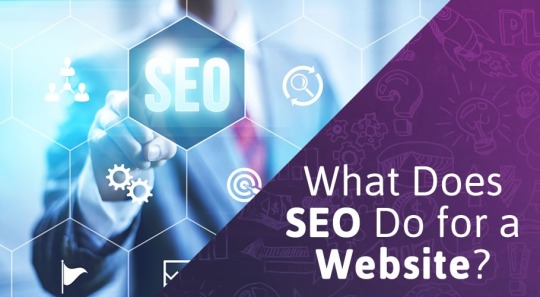
If you’re interested in the latest SEO trends, then you probably already know what search engine optimization is and how it relates to your website.
But if you’re not a marketer, then you may not know the first thing about SEO. However, if you want to appreciate the significance of SEO, then you have to understand this concept.
So, if you want to learn more on this topic, this article will explain what SEO is, what it entails, how it can benefit your business, and the consequences of ignoring it.
Keep reading here.
What Are the Latest SEO Trends?
If you want to keep up with your competitors in the SEO department, then you’re going to want to be aware of the latest SEO trends.
Otherwise, you could end up getting left in the dust while your competitors continue to climb the search engine rankings.
With that in mind, below we’ve offered our predictions for what will be the dominant SEO trends of 2024, so you can stay in the loop and be better equipped to compete.
1) Artificial Intelligence and Machine Learning
The integration of artificial intelligence (AI) and machine learning in SEO strategies is becoming increasingly prevalent.
This trend is being driven by the need for more personalized, relevant content and the ability to analyze vast amounts of data more efficiently.
AI algorithms can predict search trends, understand user intent more deeply, and automate tasks like content creation, keyword research, and SEO audits.
That being said, businesses looking to maintain and improve their search engine rankings in 2024 will benefit from using AI tools to enhance content relevance, improve user engagement, and streamline SEO processes.
What’s more, Google will soon release updates that can distinguish between AI-created and human-created content, with possible penalties for content that’s created solely by AI, so that’s something else to keep in mind, and it’ll be interesting to see how that plays out.
2) Voice Search Optimization
Voice search is growing exponentially, and that means a significant portion of searches are expected to be voice-based in 2024.
This shift is happening in large part due to the increasing use of digital assistants like Siri, Alexa, and Google Assistant.
That being said, businesses that want to improve their SEO in 2024 should do what they can to help voice assistants understand and deliver their content effectively.
This involves things like focusing on natural language, question-based queries, and local SEO elements, as voice searches are often local and conversational in nature.
3) E-A-T and User Experience (UX)
Google’s emphasis on Expertise, Authoritativeness, and Trustworthiness (E-A-T) continues to have a significant influence on search rankings, underscoring the importance of content quality and site usability.
With that in mind, sites that offer valuable, accurate content and a seamless user experience are likely to rank higher.
Businesses looking to improve their search rankings in 2024 should focus on building their reputation through quality backlinks, user reviews, and clear, authoritative content that’s aligned with user intent, while doing whatever they can to improve site speed, functionality, user interfaces, and mobile responsiveness.
4) Video Content for SEO
With the popularity of video content continuing to rise, optimizing video content for search engines is becoming a critical SEO strategy.
Believe it or not, YouTube serves as the second largest search engine, making video SEO something that can have a huge impact on the visibility of your brand.
Businesses can leverage this strategy to enhance their SEO this year by creating engaging, informative videos that cater to their target audience, using relevant keywords in titles, descriptions, and tags, and embedding videos on their websites to increase the amount of time users spend browsing them.
5) Mobile SEO
The dominance of mobile searches necessitates a mobile-first approach to SEO, and this is especially true today, as Google’s mobile-first indexing predominantly uses the mobile version of a site when determining its ranking.
That being said, ensuring your website is optimized for mobile, with fast loading speeds, responsive design, and user-friendly navigation, is more essential today than it ever has been.
At any rate, businesses that want to improve their SEO in 2024 can make use of Accelerated Mobile Pages (AMP) to create pages that load almost instantly, improving site speed and enhancing user experience on mobile devices.
6) Local SEO
Local SEO is incredibly important for your search rankings, especially if your business is targeting local customers, and I think this is going to become even more crucial in 2024.
Businesses that want to optimize for local search can do this by ensuring accurate and consistent NAP (Name, Address, Phone number) information across listings, garnering positive reviews, creating locally relevant content, and coming up with local link-building strategies.
Moreover, having an optimized Google My Business profile continues to be a key aspect of any local SEO strategy, as it allows local consumers to easily find your business online.
7) High Quality Content
With the overwhelming saturation of content on the web, depth and quality of content are becoming crucial differentiators, and this is especially true today in 2024, as it becomes harder and harder to gain the trust of consumers.
With that in mind, long-form content that thoroughly covers a topic, provides value, and addresses user questions is more likely to rank well, not least because users are likely to spend more time consuming it.
So, if you want to improve your SEO in 2024, you should focus on creating comprehensive, high-quality content that meets the needs and intents of your target audience, incorporating original research, expert insights, and actionable advice whenever possible.
8) Semantic Search and Intent Matching
As search algorithms become more sophisticated, they’re better at understanding the context and intent behind queries.
And in 2024, as artificial intelligence becomes more and more advanced, semantic search and intent matching will become critical components of any SEO strategy.
Businesses looking to improve their SEO this year should optimize their content to match the intent behind search queries, focusing on topics rather than just keywords, and structuring content to answer questions directly and comprehensively.
9) Data Privacy and Security
With increasing concerns over data privacy and security, and data breaches becoming increasingly common, websites that prioritize user privacy and data protection are likely to see a boost in trust, and in turn, rankings.
That being said, in 2024, implementing HTTPS, offering transparent privacy policies, and ensuring secure data practices will become even more important, both in terms of consumers’ perception of your brand and how your website will rank on the search engines.
10) Zero-Click Searches
If you’re not quite sure what this is, a zero-click search is when someone searches for something on a search engine but doesn’t click on any of the results.
The prevalence of these kinds of searches has been on the rise and will continue to increase in 2024, due in no small part to chatbots and Google’s enhanced SERP features, including things like Featured Snippets, which can offer information related to a search query without the user having to click on a link.
As a result, if you want your SEO to improve in 2024, you’re going to need to look for new ways to connect with users via search engines, through things like a Google My Business profile or a detailed Q&A section on your website.
11) Longer-Tail Keywords
Typically, most of a website’s visitors come from longer, more specific keyword phrases, otherwise known as long-tail keywords, which are typically three, four, or five words long.
But recently, people have been noticing something new: Longer keyword phrases, made up of seven words or more, are becoming a major source of traffic.
This is likely to continue throughout 2024 and beyond, especially since Google is becoming more intuitive at providing relevant results for users’ search queries.
So, if you’re looking to improve your SEO this year, you should start injecting some of these longer-tail keywords into your content as soon as possible.
Want to improve your website’s SEO? Why not set up a free 30-minute consultation with our SEO specialist, Daniel, to find out how we can help?
To your business success,
Susan Friesen
P.S. If you liked the article, you might want to subscribe to our newsletter. We publish tons of valuable content to help you learn more about marketing, and subscribing is the best way to ensure you don’t miss out. Additionally, if you’d like to learn more about building a search engine optimized website, click here for our free website guide.
0 notes
Text
How We Helped a Local Payment Processor Create a Brand That Stands Out in a Crowd of Giants

A Case Study on Lucid Payments
In late 2021, the founder and CEO of Lucid Payments, Surge Cumiskey, contacted us looking for help with her website.
She was disappointed with the one she had at the time, and unimpressed with the lacklustre services she was receiving from the agency that built it.
What’s more, she needed to create a brand that would be able to stand out amongst a massive crowd of giants, including the big banks, which dominate the payment processing industry.
Needless to say, trying to make such a scrappy little brand stand out against the likes of Moneris, PayPal, and Square was no small feat.
Fortunately, Surge is quite the visionary and she had already been working on her brand for years before she ever reached out to us, so she knew what she wanted.
Surge wanted to create a brand that would provide people with a better price, better service, and greater clarity, while working to protect the best interests of business owners and being bold enough to call out the nonsense going on in the payment processing industry in no uncertain terms.
That being said, by the time we heard from her, Lucid Payments already had a website, logo, tagline, and more, but its branding needed some work if it was ever going to resonate with the right audience.
Luckily, I love a challenge, and I love working with clients like Surge, who already have a vision for their brand and just need a little help getting there, so I was incredibly excited to start this project.
With that in mind, in early 2022, we got started on building Lucid Payments’ new SEO-optimized website, planning its content marketing strategy, and revamping most of its branding.
And now, after more than two years, Surge’s monthly article and newsletter are still going strong, and are continuing to solidify her brand positioning, as we look at ways to expand her audience even further.
So, if you’re looking to learn more about defining brand positioning, developing a brand, or the kind of visionary branding we offer clients, then I hope you take the time to keep reading.
WATCH: Harnessing the Power of Brand Positioning: A Five-Part Video Series for Small Business Owners

If you’re trying to create a brand and you want it to be successful, there’s a long list of things to consider and a lot that you need to know.
That being said, when it comes to brand building, one of the most important things to understand is brand positioning, which refers to how your brand is positioned in relation to your competitors.
So, if you’re looking to build a brand, then this video series is for you. It’ll give you a crash course on the various aspects of your brand positioning, including its visual and visceral impacts.
Keep reading here.
Website
When Surge first reached out to us, her website was suffering from the same trite and tired branding that many businesses attempt to employ.
It droned on and on about Lucid Payments and how great its products and services were while ignoring its audience and its problems, pain points, needs, and desires.
For example, on their old website, the main heading simply said, “Lucid Payments”, which was already a redundancy with their logo up at the top.
Then the subheading said something like, “Lucid Payments is a leading provider of technology-driven payment processing solutions for small to large enterprises in the point-of-sale, B2B and e-commerce industries,” and that’s just one of four paragraphs.
Notice that there wasn’t one mention of the customer or anything they might be dealing with here. The words you and your were nowhere to be found. Everything was just about how great Lucid Payments is.
But the fact of the matter is this type of branding just doesn’t work; at least not anymore.
The trust of consumers is getting harder and harder to earn, and they want to know that the brands with whom they’re doing business understand them, know what they’re going through, and can help to fix their problems or in some way enhance their lives or make them more convenient.
In other words, they don’t care how great your brand is. They want the focus to be solely on them and what you can do for them.
With that in mind, as you can see from the screenshot below, we rewrote the website’s heading and subheading to be all about the needs and wants of potential customers.

Instead of focusing on Lucid Payments, these headings let potential customers know that:
a) This company can help them accelerate the growth of their business.
b) Lucid Payments makes things easier for them by offering simplified payment processing.
c) The services Lucid offers are affordable, personalized, and can help them give their customers more of what they want.
This is much more effective, as it takes the focus off of Lucid Payments and positions this brand as one that understands what business owners are dealing with, as they’re speaking directly to them about their businesses and the problems they might be experiencing.
Moreover, Surge’s website included a ton of unnecessary information that would be of little to no interest to those who want her services.
It even included all the specifications of the payment terminals directly on the Home page, right down to the weight, dimensions, and ideal temperature range of each terminal.
This had to be changed, as this sort of thing was not going to get them any business, much less do anything to differentiate them.
So, aside from rewording the heading and subheading, we also analyzed everything that was on Surge’s website, removing or condensing anything that wasn’t absolutely necessary.
On the Home page, we got rid of any mention of the terminals, omitted the overly technical information, and moved the rest of that info to an inside page for those who might want to know.
As you can see below, we moved all references to payment terminals to Lucid’s new In-Store and Mobile Payments page, which summarizes these products and services, including a brief description of each payment terminal.
What used to take up a third of their Home page has now been condensed down to a few paragraphs, and the descriptions of the terminals now put a focus on what potential customers can do with these products, instead of just talking about how great they are.

What’s more, there were also a lot of things listed on Surge’s old website that were either ideas that didn’t get off the ground, or things that Lucid Payments just didn’t do anymore.
That being said, we removed anything that didn’t need to be there, shortened all the text as much as we possibly could, and cleaned up their navigation, which was an absolute mess, with nearly two dozen different options, many of which were redundant or irrelevant.
At any rate, the navigation is now much easier to use, and much less convoluted, which was necessary to ensure their website aligned with their branding, which promises “Absolute Clarity”.
In addition, we got rid of any jargon and made everything as easy to understand as possible, which is incredibly important to Lucid’s brand positioning, as it’s all about giving business owners greater clarity, and many other brands are not attempting to do this.
As you can see below, we also made sure to include nods to Lucid’s brand positioning throughout the Home page, pointing out that Lucid Payments is 100% Canadian-based, doesn’t “do business like the big guys” and has lower prices and better customer service.
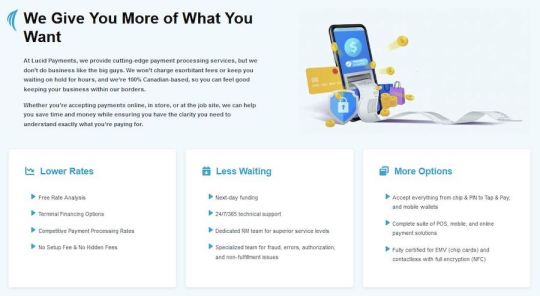
For those who want to know more, we went into even greater detail about Lucid Payments on the About page, including why people should choose Lucid, its mission statement, and of course, its values.

Among other things, this new focus on potential customers, and the unique aspects of its values being displayed prominently on its website, has allowed us to position Lucid Payments as one of the most unique, desirable, and disruptive brands in the payment processing industry.
All things considered, this has got to be one of the more challenging projects I’ve worked on over the years, but in the end, Lucid Payments’ branding is now much more effective, and it’s been great to see them continue to succeed and stand out in an industry dominated by massive corporations.
Content Marketing
As far as I’m concerned, Surge’s content marketing is where her brand truly shines.
Not only does she work with us to communicate directly with her audience through Lucid Payments’ monthly newsletter, but she can also speak frankly about all the nonsense going on in the payment processing industry, like the ongoing controversy surrounding interchange rates.
She does this by letting business owners know what to watch out for, informing them of things that they should know about, and offering practical advice that you’re not likely to get from her competitors, like how to actually save money on payment processing.
As you can see, Lucid’s blog offers a wide array of content related to payment processing, including everything from analysis of trends and new technologies to letting business owners in on how they can protect themselves and their customers from fraud.

But these are just a few examples of the content covered by Lucid Payments, which often deals with controversial, hot-button issues in the world of payment processing.
Some of the articles have attempted to dispel common myths and misconceptions about payment processing, like the idea that bigger companies can provide more secure payment processing or lower prices.
For example, the article below details several data breaches that have affected the payment processing industry, dispelling the notion that bigger processors have better security when in reality, they’re actually the biggest targets.

Not content to simply criticize her own industry, Surge has also made a point of calling out the government for its lack of action on things like interchange rates, which are incredibly high in Canada compared to other areas of the world where they’ve been capped.
As you can see below, she refuses to mince words, criticizing the Canadian government for its inaction and posturing on this issue.
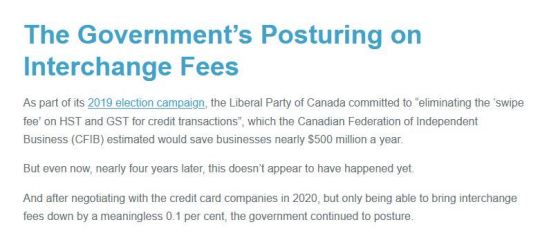
In another article on how to save money on credit card processing fees, she goes so far as to call her industry “convoluted and deceptive” before going on to provide practical advice on how merchants can save money on their payment processing.
As part of that advice, Surge even suggests incentivizing customers to use cash when they can, which certainly isn’t going to make her any money, but it shows the authenticity of her commitment to protecting the best interests of business owners.
Some may call this type of content distasteful or sensational, but Surge’s complete, unabashed honesty about the payment processing industry aligns perfectly with her brand positioning, and it’s one of the main reasons why it works so well.
Truth be told, Lucid Payments is publishing things that other payment processors wouldn’t be caught dead saying, and providing realistic advice that their competitors would rather see buried.
This may seem counter-productive, but this is the sort of thing that has allowed Lucid Payments to be positioned as one of the most authoritative and trustworthy brands in payment processing.
And after more than 20 years of helping business owners build their brands, I can honestly say that Lucid Payments offers one of the best examples of brand positioning in action.
Looking to create a brand, but need help bringing your vision to fruition? Contact us today to find out more about how we can help.
To your business success,
Susan Friesen
P.S. If you liked the article, you might want to subscribe to our newsletter. We publish tons of valuable content to help you learn more about marketing, and subscribing is the best way to ensure you don’t miss out. Additionally, if you’d like to learn more about building a search engine optimized website, click here for our free website guide.
1 note
·
View note
Text
5 Content Marketing Trends That Will Dominate in 2024

Without a doubt, content marketing offers one of the best ways to market your business online.
But if you want your content to convert, and be able to compete with everything else that’s out there, you’ve got to keep track of the dominant content marketing trends.
Otherwise, your content may end up being much less relevant, and you could miss out on some amazing techniques and tools to help you improve your content marketing strategy.
Now, if you’re someone who doesn’t know much about content marketing, at this point, you may be wondering, “What is the point of all this?”
Truth be told, that’s a pretty loaded question, and I could easily write an essay on that subject alone.
But in short, the point of content marketing, and following content marketing trends, for that matter, is to use relevant and valuable content to attract and engage a target audience, building trust and awareness of your brand, while ultimately guiding potential customers toward making a purchase decision without trying to sell them anything directly.
That being said, the reason why so many marketers focus on content marketing is because it works, and as I pointed out in my last article on blogging, it offers one of the highest returns on investment of any marketing channel.
And as many marketers will attest, as time goes on, content marketing is only becoming more important.
For example, survey data published by the Content Marketing Institute last year, which compiled responses from more than 1,100 content marketers from around the world, found that the vast majority of them believe that content marketing is becoming increasingly important.
As you can see from the graphs below, 71 per cent of B2B content marketers surveyed said they believed content marketing was more important that year than in the previous year, and 70 per cent of B2C content marketers said the same thing.
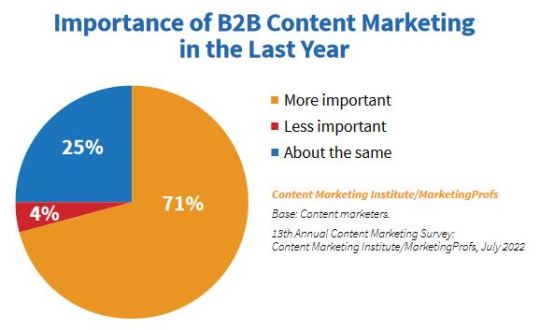
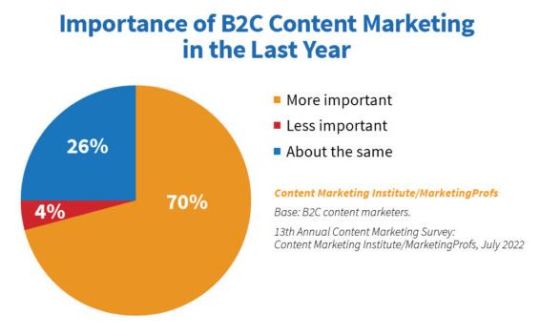
As you can see, there’s a reason why so many businesses are leveraging content marketing, and why its popularity continues to increase.
So, if you want to inform your content marketing strategy for the coming year, or you’re just looking to learn more about the content marketing trends 2024 will be dominated by, then this is an article you’re not going to want to miss.
Read: How the Benefits of Blogging Can Seriously Help Your Website and Boost Your Business in 2024

If you’re looking to leverage content marketing, it’s important to understand not just what it is, how it works, and what’s trending, but also the benefits it can offer your business.
From enhancing your website’s SEO to gaining a better understanding of your target audience, content marketing provides no shortage of advantages to those who choose to use it.
So, if you’re thinking about using content marketing for your business, and you want to learn more about all the benefits it has to offer, this article will tell you everything you need to know.
Keep reading here.
5 Content Marketing Trends For 2024
As much as you may want to, when it comes to content marketing, you can’t just throw stuff at the wall and hope it sticks.
And if you want to create the best content you can, you’ve got to be aware of the content marketing trends that are set to dominate in 2024.
With that in mind, below I’ve listed the trends that I believe will dominate the world of content marketing over the coming year, along with why they’re so dominant, and what you can do to make use of the tools and techniques offered by these trends.
1) Artificial Intelligence (AI)
Whether it’s using ChatGPT to create textual content, DALL-E to create AI-generated images, or something else entirely, there’s a reason why artificial intelligence is at the top of my list of 2024 content marketing trends.
Artificial intelligence is set to dominate content marketing in 2024 due to its ability to enhance efficiency, personalization, and targeting, while providing valuable insights and automating content creation, which enables marketers to focus on strategic priorities and more effectively adapt to the ever-changing and fast-paced world of digital marketing.
Businesses can leverage AI for their content marketing by using natural language processing for content creation, AI-driven analytics for audience insights, and machine learning for personalized content recommendations.
Moreover, AI can be used to automate email marketing campaigns, segmenting audiences based on behaviour and preferences for more targeted messaging, and AI-powered tools can even optimize SEO strategies, suggesting keywords and content topics that are likely to perform well.
But if you’re using ChatGPT to create blog articles, for instance, make sure that you don’t just take what it gives you and post it to your website as is, otherwise, it’s going to be pretty obvious that it was written solely by artificial intelligence, and that’s never a good look.
In any case, you’re still going to need to do some editing to add your brand voice, humanize the content, and edit out any telltale signs of AI-written content, which people are starting to recognize, such as the overuse of certain kinds of formatting, punctuation, words, and phrases.
2) Short-Form Video Content
I hate to say it, but as the years go by, people’s attention spans are only getting smaller.
And when you look at the kind of video content people are consuming, this becomes obvious, as seen by the meteoric rise in the popularity of platforms like TikTok and Instagram Reels, both of which make use of exclusively short-form videos, offering quick, engaging, and easily digestible content.
These platforms provide higher engagement rates and shareability, making short-form videos a powerful tool for brands to quickly capture attention, convey messages, and drive viral marketing campaigns that can significantly enhance their online presence and audience engagement.
That being said, short-form video content will continue to dominate content marketing in 2024 due to its alignment with the fast-paced, mobile-first consumption habits of today’s audiences, especially younger demographics like Gen Z.
Businesses can use short-form video content in their content marketing by creating things like engaging product demos, behind-the-scenes looks, customer testimonials, and short how-to guides. These videos can help brands showcase their personality, highlight the features of their products and services, and answer common questions in an entertaining way.
3) Search and Social Media Integration
One thing that many people tend to forget about social media platforms like TikTok and Instagram is that they are also search engines.
And considering the surging popularity of these platforms, it’s important to understand that consumers are shifting their focus from traditional search engines like Google to the search engines found on social media sites.
With that in mind, content marketers will need to focus not just on consistently creating authentic, relevant, and relatable content, but also on optimizing their content for discoverability on these platforms, where so many people are consuming content today.
Businesses can harness search and social media integration for their content marketing by creating platform-specific content that is optimized for the search features of social media sites frequented by their respective audiences.
In addition, by using relevant hashtags, participating in trending challenges, and engaging in popular conversations, businesses can increase their visibility on these platforms. And by leveraging the search intent data from social media, businesses can tailor their content to ensure it answers their audiences’ questions and addresses their needs, which can make it more discoverable.
What’s more, by incorporating user-generated content and interactive elements such as polls and quizzes, businesses can further boost engagement and foster a sense of community, driving brand awareness and customer loyalty.
4) Value-Driven Content
Content that reflects a brand’s values will become much more important in 2024, as the trust economy continues to grow, and consumers increasingly choose to give their business to brands whose values align with their own.
That being said, marketers will have to focus on creating content that showcases their brands’ stances on relevant topics if they want to maintain a positive relationship with their target audiences.
Value-driven content is a trend that’s been around for quite some time, but it’s poised to dominate content marketing in 2024, as consumers today are more likely to want to do business with brands that reflect their personal values and understand their societal concerns.
Content that authentically aligns with issues like sustainability, diversity, and social responsibility will stand out from the rest, fostering deeper connections between brands and their audiences. And by prioritizing transparency, ethical practices, and community engagement, and highlighting these things in their content, businesses can build trust and loyalty, turning casual consumers into brand advocates.
Businesses can use value-driven content in their content marketing by sharing stories that show their commitment to social responsibility, sustainability, and community involvement.
For example, businesses can publish blog posts about their eco-friendly manufacturing processes, create videos showcasing their support for local charities, produce infographics that educate audiences on important social issues related to their industries, incorporate customer testimonials that resonate with their brands’ values, and engage in social media campaigns that promote positive social change.
5) Branded Communities
The term branded community is a relatively new term that didn’t show up until around the turn of the century. In the context of digital marketing, it refers to an online space created by a brand to foster interaction, engagement, and deeper relationships with its customers and between those customers.
These communities are built around shared interests, values, or enthusiasm for a brand’s products or services. They might take the form of forums, social media groups, or dedicated platforms where members can share experiences, offer feedback, participate in discussions, and gain access to exclusive content or support.
Branded communities have become more and more popular in recent years, and I believe they are set to dominate the world of content marketing this year, as we continue to see more and more examples of the benefits these communities can offer for their brands.
Not only do they offer a unique platform for deepening customer engagement and loyalty, facilitating direct interaction between brands and consumers, but they also allow for things like personalized experiences, peer-to-peer support, and user-generated content.
A great example of this is LEGO Ideas, a branded community where fans can interact with other users, submit their own LEGO set ideas, and vote on submissions. Selected ideas may even be turned into official LEGO sets, with creators receiving recognition and a share of the profits.
Businesses can use branded communities in their content marketing by creating exclusive spaces where customers can engage in discussions, share experiences, and provide feedback.
What’s more, these communities can also be platforms for launching new products, conducting polls or surveys for customer insights, and encouraging users to create their own content.
Want to improve your company’s content marketing strategy for 2024? Why not book a free 30-minute consultation with me to find out how we can help?
To your business success,
Susan Friesen
P.S. If you liked the article, you might want to subscribe to our newsletter. We publish tons of valuable content to help you learn more about marketing, and subscribing is the best way to ensure you don’t miss out. Additionally, if you’d like to learn more about building a search engine optimized website, click here for our free website guide.
0 notes
Text
How the Benefits of Blogging Can Seriously Help Your Website and Boost Your Business in 2024

In this day and age, the benefits of blogging couldn’t be any more obvious.
Its advantages have been demonstrated countless times, and while there used to be a bit of a debate about whether or not it was worth it to write blogs, that argument has been over for quite some time.
To be fair, I’ve been working in marketing for more than 20 years, so I’m much more aware of the benefits of having a blog, and I’ve seen firsthand the impact blogging can have.
But for whatever reason, a lot of business owners are still willing to discount the benefits of blogging.
Often, it’s because they don’t have the time, or don’t want to make the time, to sit down and do the writing, but even if they get someone else to do it, it’s common for them to have very unrealistic expectations, or just not understand the value of blogging at all.
But regardless of these erroneous ideas, having a blog can offer many benefits for your business, and this is as true now as it was when I got into marketing.
For instance, a report from HubSpot, which surveyed more than 1,200 marketers from around the world, found that blogging is tied with social media shopping tools and influencer marketing for having the highest return on investment of any marketing channel.
Moreover, as you can see from the graph below, in a survey from Orbit Media Studios, which polled 1,000 bloggers, the vast majority of them said that their blogging efforts have driven results in 2023, including things like more leads and website traffic, and greater brand awareness, and one in four respondents said their blog “delivers strong marketing results”.

Studies like this show without a doubt that having a blog can significantly benefit your business, but as is the case with so many business owners, you might still be on the fence.
With that in mind, I want to break down the many benefits of blogging to help you understand why this is such an important practice.
So, if you’re asking, “What is the point of blogging?” or you just want to learn more about the benefits of having a blog, then this is an article you’re not going to want to miss.
Read: 9 Ways To Make Your Blog More Engaging

Blogging offers a long list of benefits for businesses, but coming up with content that’s actually going to engage your audience is easier said than done.
You can’t just write whatever you want and expect your audience to be interested, and consistently coming up with new ideas can be tough.
With that in mind, this article offers nine tips to make your blog more engaging, including updating your blog, publishing long-form content, and more.
Keep reading here.
What Are the Benefits of Blogging?
Despite all the business owners out there who insist on discounting the benefits of blogging, the fact of the matter is having a blog on your website can benefit your marketing efforts in many different ways.
With that in mind, below I’ve listed some of the most important benefits of having a blog, so you can understand just how beneficial it is for your business to have one.
Enhancing Online Visibility Through SEO
One of the most crucial benefits of having a blog for your business is how it can help you to search engine optimize your website. Here’s how blogging can help you improve your search engine rankings:
Search Engine Optimization: Regularly publishing blogs with relevant, keyword-rich content can increase the likelihood of your website ranking higher in search engine results. This enhanced visibility is vital, as higher search engine rankings can significantly increase your business’ exposure to potential customers.
Long-Tail Keywords: Having a blog gives you the opportunity to integrate long-tail keywords into your content, which are highly specific phrases that are less likely to face stiff competition. By targeting these keywords, you can attract more qualified leads who are more likely to make a purchase.
Backlinks: Quality blog content can help you earn backlinks from other reputable websites that have taken the time to link to your content. Backlinks are invaluable for SEO, as they can boost your website’s domain authority, signaling to search engines that your content is valuable and trustworthy, which can further improve your search rankings.
Building Brand Identity and Establishing Authority
If you want to stand out amongst your competitors, you need to be seen as an authority, and you need a unique brand identity. Having a blog can help you accomplish this by allowing you to:
Demonstrate Expertise and Leadership: Through well-researched and insightful blog posts, your business can showcase expertise and knowledge, and this helps you to establish authority and credibility, which are key for building trust with potential customers.
Develop Your Brand Voice: Blogs can allow you to express your brand’s personality and values, helping you to distinguish yourself from competitors. A unique and consistent brand voice can have a significant impact on your target audience, creating a strong emotional connection.
Offer Industry Insights and Trends: Regular blogging about industry trends, insights, and news helps to position your business as a go-to source for valuable information. This not only reinforces your business’ role as an industry leader but also keeps customers engaged and informed.
Engaging and Understanding Your Target Audience
Great content marketing is all about understanding your target audience, and blogging offers a great way to go about doing this. Blogging can help you understand and connect with your audience through:
Direct Engagement: Blogs give you a platform for direct interaction with your audience through comments and feedback. This interaction fosters a sense of community and loyalty, which can help turn readers into loyal brand advocates.
Customer Insights: Analytics from blog interactions provide invaluable data on your customers’ preferences and behaviours, and having a better understanding of which topics resonate with your audience can guide future marketing strategies and content creation, even outside of your blog.
Personalized Content: Blogging gives you the ability to address various segments of your audience with tailored content. This personalization can significantly increase the relevance and effectiveness of your marketing efforts.
Driving Traffic and Lead Generation
Regularly publishing blog posts is one of the best ways to drive traffic to your website and generate high-quality leads. Here’s how blogging can help you to do that:
Consistent Website Traffic: Each blog post represents a new page on your website, which increases the likelihood of it being found on search engines and drawing in traffic. This consistent flow of traffic is vital if you want to consistently generate leads and make sales.
Effective Calls-to-Action: Strategic placement of calls-to-action in blog posts can help you encourage your audience to convert. Whether it’s signing up for a newsletter, downloading a whitepaper, or inquiring about a service, effective calls-to-action can turn passive readers into active leads.
Content Syndication: Blog posts provide shareable content for social media platforms, extending your reach far beyond just your website. Sharing content on social media can also increase your likelihood of earning valuable backlinks, which can further improve your SEO.
Customer Relationship Management
Having a blog for your business is a great way to interact with your audience and build an emotional connection with customers. Blogging on a regular basis can benefit this aspect of your business by:
Building Trust with Educational Content: Providing educational and informative content can help solve customers’ problems and answer their questions, which allows you to build trust and position your brand as an authoritative, helpful resource.
Improving Customer Retention: Engaging and relevant blog content can encourage customers to return to your website, which is crucial for nurturing long-term customer relationships.
Leveraging Feedback and Interaction: Blogs offer a space for customers to provide feedback, ask questions, and interact with your business. This direct line of communication is often overlooked but offers an incredibly effective way to improve products and services and better understand the needs of your customers.
Analytics and Strategy
Blogging also gives you the chance to analyze the types of content your audience likes best and be strategic about what kind of content you decide to publish. Here are some of the ways you can do that:
Using Analytics for Insights: Tools like Google Analytics can track blog performance, offering insights into the behaviour of your website visitors, the popularity of your content, and conversion rates. These metrics are essential for understanding the effectiveness of your blogging efforts.
Optimizing Your Strategy Based on Data: Analyzing blog performance data gives you the chance to refine your business’ content strategy, allowing you to focus on topics and formats that yield the best results. This data-driven approach can help you ensure you’ll see a higher return on investment from your content marketing efforts.
Gaining a Competitive Advantage: When there are so many businesses out there that don’t have blogs, or don’t regularly update them, having a well-executed blogging strategy can provide a substantial competitive edge and help to improve your brand positioning.
Do you want to start a blog but just don’t have the time? Why not book a free 30-minute consultation with me to find out how we can help?
To your business success,
Susan Friesen
P.S. If you liked the article, you might want to subscribe to our newsletter. We publish tons of valuable content to help you learn more about marketing, and subscribing is the best way to ensure you don’t miss out. Additionally, if you’d like to learn more about building a search engine optimized website, click here for our free website guide.
0 notes
Text
How to Respond to a Negative Review in the Best Way Possible

Unfortunately, in the age of the internet, it’s way too easy for hot-headed customers to take their grievances online – whether legitimate or not – by writing bad reviews.
And even if you’ve done nothing wrong, and they have no real reason to complain, when a customer doesn’t feel that their situation has been properly resolved or they feel like they haven’t been listened to, word of mouth can spread like wildfire.
You’ve probably witnessed this many times yourself when a company has supposedly wronged an irate customer and suddenly everyone is adding their story to the mix. It can get ugly very fast.
But when it comes to your brand’s reputation, how you handle the situation can make all the difference in the world, and the right response to a bad review can turn a potential disaster into a real triumph.
So, if you’re wondering how to respond to a bad review, then you’re going to want to keep reading.
Because in this article, I’m going to highlight some of the biggest mistakes business owners make when responding to bad reviews, provide an example of how we’ve responded to one, and explain how to respond to negative reviews in the best way possible.
Read: How This One Thing Can Destroy a Client Relationship
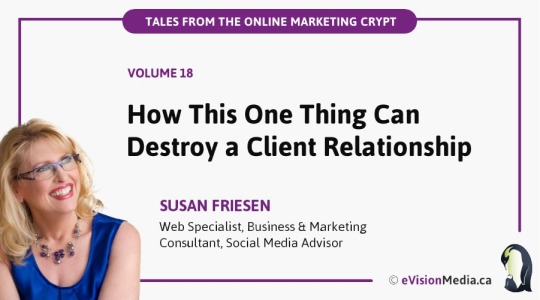
Responding poorly to a negative online review isn’t the only way to ruin a relationship with a client.
Being in a bad mood and acting without thinking first can easily destroy client relationships, whether the interaction takes place online, over the phone, or in person.
In this article, I offer eight tips on what you can do to avoid creating irreparable situations with clients, so you can stop this sort of thing from happening before it starts.
Keep reading here.
Mistakes to Avoid When Responding to Bad Reviews
Before I offer my advice on how to respond to a negative review, let’s talk about what not to do.
With that in mind, here are some of the biggest mistakes I’ve seen business owners make when responding to negative reviews online:
They take the review personally, get defensive, and decide to have an online shouting match with the customer.
They have friends post fake reviews on their behalf in an attempt to run damage control.
They escalate the situation by denying there was a problem to begin with or start blaming the customer, which makes them even angrier, resulting in an even more negative impact.
They become downright rude, hurtful, or make snide comments about the customer.
They refuse to take responsibility, and instead just point their fingers and blame something and/or someone else.
Aside from these classic mistakes, many business owners will tend to avoid monitoring their reviews at all and think, “What I don’t know can’t hurt me.”
But if you have this kind of attitude, not only will you be unaware of these bad reviews, but you’re also giving up the chance to respond to them, and you really don’t want to do that.
Because as we saw from the data above, consumers are more likely to visit a business that responds to negative reviews, which means not responding to these reviews can actually be worse than getting them in the first place.
Now, before I move on here, I think it’s important to talk specifically about reviews on Google, as this is where most people are looking up reviews on businesses.
People are known to leave bad reviews on Google for no good reason, and one of the reasons they do this is simply to mess with their competitors’ reputations.
We’ve experienced this ourselves with the one bad review we have on Google.
As you can see below, when we got this review, we knew something was up right away, as no comment was left, and the user simply gave us a one-star review for no apparent reason.
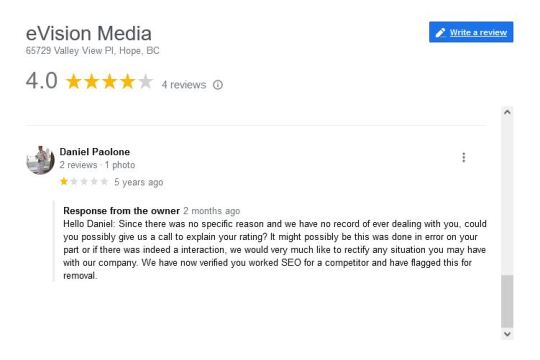
However, when we looked into it, we found that this person worked for one of our competitors and was probably just trying to mess with us.
So, we flagged this comment for removal, as what this user is doing more than likely violates Google’s guidelines when it comes to reviews.
But it’s important to note that despite the malicious nature of this review, we still responded to it politely and professionally, making sure to let this person know that we’re eager to rectify the situation.
At this point, you might be wondering if it’s possible to remove Google reviews, and it is, but only Google can remove them, and they’ll only do that if the review violates their guidelines.
As you can see from the screenshot above, this is often an incredibly lengthy process, as we flagged this review for removal more than two months ago but obviously, it’s still there.
That being said, in situations like this, it makes sense to flag the review for removal, as this is clearly a malicious act, but don’t expect anything to be done about it any time soon, if ever.
Most importantly, you should still reply to the review in the same polite and professional manner that you would use when responding to any other one.
How to Respond to a Negative Review
Now that you know about some of the biggest mistakes business owners make when responding to bad reviews, and you’ve seen an example of how you should respond, let’s talk about how to respond to a negative review in the best way possible.
With that in mind, here are some tips to help you monitor and manage your brand’s reputation when responding to bad reviews online:
Monitor Your Online Reputation
One thing you can do to help you monitor your online reputation is to set up Google Alerts for your company name so that whenever a new mention of your business appears online, you’ll be notified.
Hootsuite is another tool you can use, which notifies you when customers comment on social media.
Both of these tools are great because they allow you to monitor your brand’s online reputation in real time, and help you respond to these reviews in a timelier manner.
Keep Your Cool
As I already mentioned, starting a flame war with a customer because they left a bad review is one of the biggest mistakes you can make, so make sure to keep your cool no matter what.
You should try to look at bad reviews as an opportunity for improvement, because customer feedback, whether it’s good or bad, can reveal ways to improve your products and services or make you aware of issues you didn’t even know about.
It’s also important to mention that you shouldn’t respond if you’re feeling angry, hurt, or defensive; always wait until you’ve calmed down and can respond in a professional, courteous, and respectful manner.
Be Grateful and Polite
Something else you should make a point of doing when responding to negative reviews is to thank the customer for their loyalty and feedback.
Try to look at things from their perspective, acknowledge the problem, get all the relevant facts, and let them know you have heard their complaint.
In addition, make sure to explain that it’s important to you that you resolve their situation, and don’t forget to share what you’re going to do to make it right.
Respond Publicly
When other customers see you going out of your way to make a bad situation right, it helps to retain their trust, and as was shown by the data above, if you respond to bad reviews online, many consumers will actually be more likely to give you their business.
In any case, this is incredibly important, because if your reputation has been bruised, even by one bad review, you’ve got to earn back the trust you’ve lost if you want customers to continue doing business with you.
And one of the best ways to do that is by doing everything you can to resolve the issue openly and honestly.
Take Ownership of the Complaint
It’s easy to blame someone else on your staff for the blunder or point fingers at failed technology or whatever the case may be.
But as a business owner, taking responsibility for the issue and dealing with it in a calm, professional manner will help enhance your brand’s reputation and can convert an unhappy customer into a happy one because they feel their concerns have been heard and addressed.
When you make a point of doing this, you can be sure other people are going to hear about it, and word of mouth will continue to spread about how you treat your customers.
So, if you want to be smart about how you respond to negative reviews, the next time you’re faced with one, try to be thankful for the feedback and use it as a learning opportunity, and an opportunity to protect your brand’s online reputation.
Because when you welcome customer complaints, and use this criticism to improve your products and/or services, it can lead to more satisfied customers, better products and services, and a greater grasp of how to deal with these kinds of situations.
Have you encountered negative reviews about your business yet? Let us know how you handled them in the comments below.
Do you need some help protecting your brand’s reputation online? Why not book a free 30-minute consultation with me to find out how we can help?
To your business success,
Susan Friesen
0 notes
Text
12 Trends in Marketing to Watch Out for in 2024

With winter just around the corner, and Christmas coming up fast, it really is hard to believe that 2023 is almost over.
It seems like just a few weeks ago my team and I were meeting to discuss ChatGPT and decide how we’ll be using artificial intelligence moving forward.
But then again, after using AI on practically a daily basis for nearly a year, it almost feels like these tools have been around forever, and it’s hard to think back to a time when we didn’t have them.
I suppose this is just another reminder of how important it is to stay up to date on trends in marketing, as this industry is always changing rapidly, and AI seems to have accelerated that change even further.
That being said, I’m guessing that 2024 is going to be another incredibly transformative year in marketing, not least because of how the use of AI is expanding.
In any case, now is the time of year when I try to take stock of the latest marketing trends, so I can stay ahead of the curve and gain a competitive advantage in the new year.
With that in mind, I want to pass these insights on to you, so you can ensure you’re doing everything you can to market your business as effectively and efficiently as possible.
So, if you’re looking to learn more about the trends in marketing that are set to dominate in 2024, then this article is definitely for you.
Read: How Your Small Business Can Easily Leverage AI

If you want to know where the world of marketing is headed, you’re going to need to understand AI, at least in terms of what it’s capable of doing.
This technology has applications in pretty much every form of marketing, including each and every one of the trends in marketing I’ve listed below.
So, if you want to have a better idea of where marketing is going, and how you can leverage AI for your business, then you’re going to want to read this article.
Keep reading here.
The Top Trends in Marketing for 2024
1) Enhanced Personalization
In 2024, businesses will be better equipped than ever to harness data analytics and AI to create highly personalized customer experiences by using customer data to tailor things like marketing messages, product recommendations, and shopping experiences.
This enhanced personalization will also extend into email marketing, website content, and even product development, helping businesses build stronger relationships with their customers and stand out in crowded markets.
2) Value-Driven Content Marketing
As the old saying goes, content is king, and with AI tools like ChatGPT pumping out who knows how many pieces of content every minute, as we move into 2024, all forms of content will have to provide even greater value in order to perform well.
This means that brands will have to focus more attention on the needs, wants, and interests of their audiences, pay more attention to the kinds of content competitors are creating, and get even more strategic and creative with the content they’re producing.
3) The Rise of the Metaverse
Brands making use of the metaverse will become even more common in 2024, as this platform offers a ton of unique opportunities for brands to engage with their audiences, using virtual and augmented reality to go far beyond traditional online or physical marketing.
We haven’t seen too much of this yet, but I think in 2024, we’re going to see more and more brands making use of this virtual world for things like virtual events and product launches, the sale of virtual goods and services, and collaboration between brands and consumers on virtual projects.
4) Growth in Programmatic Advertising
Even though this technology has been around for quite some time, the automated and data-driven ad placements that programmatic advertising provides will become even more relevant in 2024.
For one thing, as AI and machine learning technologies continue to advance, and the pool of data that’s available becomes larger and larger, programmatic advertising will be able to offer even better audience segmentation, more precise targeting, and better returns on investment for advertisers.
At the same time, with economic conditions the way they are, businesses can’t afford to waste a dime, and the cost-effectiveness offered by this technology will be too tempting to ignore.
5) Leveraging AI and Automation
The increasing accessibility of AI and automation has allowed more and more businesses to leverage these tools, and that’s only going to accelerate as we move into 2024.
These tools can significantly increase efficiency by automating repetitive marketing tasks like social media posting, sending email responses, optimizing ad spend, and analyzing the behaviour patterns of customers, and they’re going to be game-changers for every business that chooses to use them.
All things considered, it’ll be interesting to see how AI and automation becoming more accessible will help to level the playing field, as there was a time when these kinds of tools were only available to large corporations.
6) Social Responsibility and Ethics
Consumers today tend to prefer brands that demonstrate ethical practices and social responsibility, and I think this trend is going to become even more prevalent throughout 2024.
The polarization and politicization of everything seems to be exponentially increasing, with no end in sight, and as a result, many consumers don’t want to do business with companies whose values don’t align with their own.
Businesses can capitalize on this trend by highlighting their ethical sourcing, sustainable practices, community engagement, or support for social causes in their marketing strategies, and this approach not only helps to attract customers but also builds long-term brand loyalty and trust.
7) Expansion of eCommerce
The rise of eCommerce is a trend that’s been going on for quite some time, but with everything that’s happened over the last few years, more and more people are choosing to shop from the comfort of their homes, and I don’t think that trend is going to slow down any time soon.
That being said, in 2024, eCommerce capability is going to become even more important, and businesses that are already selling online will be looking to enhance the shopping experience in innovative ways.
This may include adopting new technologies, like using augmented reality so people can “try on” clothes virtually, or more practical methods, like focusing on niche markets, improving mobile eCommerce, and offering unique products or personalized services online that are not readily available in retail outlets.
8) Optimizing for Voice Search
With more and more devices utilizing voice activation tools like Alexa, Bixby, Siri, Cortana, and Google Assistant, optimizing for voice search will become increasingly important in 2024 and beyond.
As a result, businesses will need to adapt their search engine optimization (SEO) strategies by ensuring they focus on conversational keywords and phrases that people are more likely to use when searching the internet using their voice.
9) Localized Marketing Strategies
With everyone glued to their phones these days, businesses will have to continue to focus on localized marketing, especially if they have a physical location.
This means they’ll have to optimize for local SEO, concentrate more on “near me” searches, and ensure their businesses are prominently listed and accurately represented on local directories, maps, and platforms like Google My Business.
10) Embracing Video Marketing
I know this is a trend that has been going on for many years, and will probably never go away, but I think we’re likely to see another exponential increase in this form of marketing in the coming year for several reasons.
For one thing, video editing has never been more accessible, with easy-to-use and even free video editing tools becoming increasingly common, allowing more and more businesses to make use of this medium.
At the same time, the unfettered growth of platforms like Instagram, YouTube, and TikTok shows that consumers continue to prefer this kind of content, and as brands try to enhance the online shopping experience, eCommerce applications, like the use of explainer videos, will also grow in popularity.
11) Building and Nurturing Community
More than ever, there’s a need for businesses to build a community around their brand. This is something we’ve been seeing for many years, and I think we’re going to see more and more of this.
So, in 2024, you can expect to see more active engagement on social media platforms, along with brands creating exclusive groups or forums where customers can interact and developing loyalty programs that reward customer engagement.
12) Prioritizing Privacy in Marketing
With increasing scrutiny on data privacy, especially as AI tools like ChatGPT have been made publicly available, in 2024, businesses will need to focus more on ensuring that their marketing practices are transparent and comply with data protection laws.
This approach avoids legal pitfalls, helps to build trust with consumers, and includes strategies like being clearer about how customer data is collected and used and providing customers with control over their data whenever possible.
Do you need help integrating any of these marketing tools or strategies into your business? Why not book a free 30-minute consultation with me to find out how we can help?
To your business success,
Susan Friesen
0 notes
Text
How Your Small Business Can Easily Leverage AI

It’s been less than a year since ChatGPT was launched, and already it’s changed the business landscape in ways we can only begin to imagine.
But even a few years ago, if you’d told me I’d soon be publishing an article on how to use AI for small business, I would have thought you were out of your mind.
Up until recently, the idea of artificial intelligence seemed like something straight out of a science fiction flick, and the thought of it being readily available to anyone with an internet connection had never even seemed like a possibility.
But lo and behold, AI is now the hottest thing in business, and quickly becoming something that business owners across the board can no longer afford to ignore.
The applications of AI are truly staggering, and like it or not, businesses are going to have to learn to leverage these tools if they want to continue to compete.
And even with all the negativity, hesitation, and suspicion surrounding this software, it seems like most businesses have already started using it, or are at least planning to do so.
According to a survey from Intuit QuickBooks, which targeted small businesses, more than eight out of ten respondents are already using AI at work, more than a third of them use it every day, and 65 per cent of them said they want to make more use of AI than they already are.
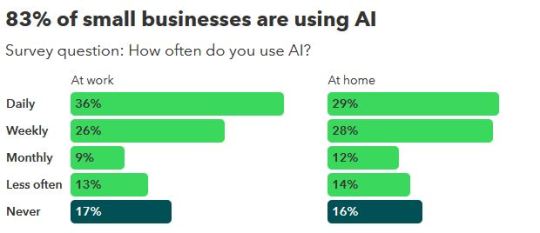
What’s more, the survey found that more than two-thirds of respondents agree that AI could contribute to the success of their businesses and 70 per cent agree that AI could help them to compete with larger businesses.
Aside from exploring the reasons why people are choosing to use AI for small business, the survey also exposed why some businesses are still hesitant to use these tools.
Despite the overwhelming enthusiasm that these small business owners seem to have for AI, more than 90 per cent of respondents have at least one concern about it, with the top three concerns being issues related to privacy, lack of regulation, and how this technology may end up taking people’s jobs.
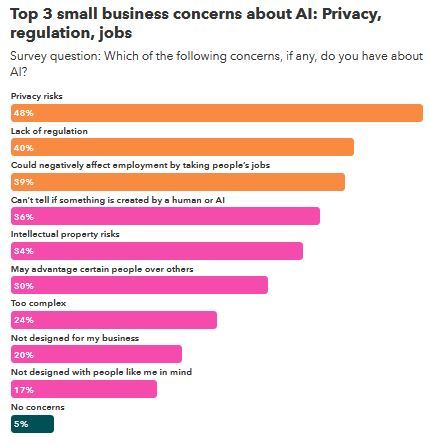
All things considered, it’s obvious that small business owners are excited about using AI, and the benefits it can offer their businesses, but they’re also quite worried about the potential implications of using this technology, and rightfully so.
That being said, a lot of ridiculous claims have been made about AI in terms of what it’s capable of doing and the effects it might have on society, not least when it comes to business.
But as I mentioned earlier, this technology is something that can no longer be ignored if companies want to continue to be able to compete in their industries.
With that in mind, I wrote this article to dispel some of the myths and misconceptions about this technology and provide greater context on how you can use AI for your small business, so you can get ahead of the curve now before it’s too late in the game.
So, if you’re interested in learning more about AI applications for small business or somewhat skeptical of this technology and still on the fence about using it, then you’re going to want to keep reading.
My Take on AI for Small Business
I think it’s safe to say that I and my team would be considered early adopters of AI tools like ChatGPT, both for eVision Media, and my own personal brand.
Truth be told, we all had our own worries about AI, and we even held a couple of meetings to discuss our concerns and explore how we could use this technology to benefit eVision Media and our clients.
But before the dust settled on all the myths and misconceptions surrounding AI, I already knew that this was something we were going to have to get used to using, otherwise we’d be left in the dust.
The controversy around AI always reminds me of what happened when WordPress came out, and we were having meetings to decide whether or not we were going to use that tool.
Fast forward 20 years, and WordPress is now used to build the majority of websites, and no web developer in their right mind would debate whether or not we should be using it.
So, as I became aware of the seemingly endless applications of AI, and the speed with which it grew in popularity, the writing was already on the wall – this was something we were going to have to use, and we needed to figure it out fast.
Less than 12 months later, both I and my team have fully embraced the use of AI in our work, and have been incredibly excited to see how this technology has made our work easier and allowed us to provide better services and more value for our clients.
However, right from the get-go, people were making a bunch of claims about AI that always seemed pretty far-fetched, and luckily, for the most part, they’ve proven to be untrue.
Unfortunately, a lot of this ridiculous rhetoric continues to persist, even almost a year after ChatGPT’s release, so before I get into talking about how to leverage AI for small business, I want to address some of this stuff.
First off, as I’m sure you already know, even though these AI tools have been publicly available for nearly a year, we still haven’t been made obsolete.
Clients continue to come to us to handle their marketing, and if anything, they’re happier with our services than they ever have been, as these tools have just made us better at everything we do.
Moreover, as far as I know, entire industries have not been wiped out as a result of AI, and it doesn’t look like that’s going to happen – at least not any time soon.
As for whether or not AI will inevitably surpass humanity in every conceivable way and end up enslaving us all, that’s a subject for another article.
But if you want to use AI for small business marketing, you still need to have a deep understanding of marketing and know how to properly use AI to get it to do what you want.
What’s more, after almost a year of pumping out blog articles, social media posts, and email campaigns, many people can tell when content has been created by AI, and this is something that also has to be accounted for.
So, despite what you may have been told, AI won’t allow you to fire your entire marketing team and do everything yourself.
But just like it has for us, AI tools like ChatGPT can make your marketing team more productive, and improve the quality of the content they’re creating.
On that note, let’s explore what you need to know to leverage AI for your small business.
Read: Why Is Everyone so Afraid of ChatGPT?

If you want to understand how best to benefit your business using tools like ChatGPT, you’re going to need a deep understanding of what they’re capable of doing, and what they’re not able to do.
It’s also not a bad idea to gain a better grasp of all the apprehension surrounding these tools, so you’re not being misled or thinking they’re something they’re not.
So, if you want to learn more about ChatGPT, and why everyone seems to be so scared of it, then this is an article you’re not going to want to miss.
Read more here.
6 Ways to Leverage AI for Your Small Business
I understand that you might still be skeptical of AI, and hesitant to use it for your small business, but the fact of the matter is your competitors are already using AI, and if you don’t learn to leverage it for your business, you’re going to get left behind.
With that in mind, let’s explore some of the most exciting AI applications for small business and how you can go about implementing this technology.
1. Streamlining Operations and Automating Tasks
AI-powered automation tools can handle repetitive and time-consuming tasks, allowing you to provide relief for employees, and spend time focusing on more lucrative endeavours.
Chatbots, for instance, can manage customer inquiries and provide basic support 24/7, reducing the burden on your sales and customer service teams.
2. Personalizing Customer Experiences
AI gives you the ability to collect and analyze vast amounts of customer data, which can allow you to personalize interactions with customers.
Recommendation engines, for instance, which are based on AI algorithms, can suggest products or services tailored to individual preferences, thereby increasing sales, and ensuring you’ll have even more satisfied customers.
3. Enhancing Marketing Strategies
As we’ve learned over the last 12 months, small businesses can leverage AI to understand consumer behaviour, optimize marketing campaigns, create content more quickly than a human could ever dream of, and target specific demographics more effectively.
For example, AI tools like ChatGPT can predict trends, identify patterns, and optimize ad placements across various platforms, allowing you to get a better return on investment.
4. Improving Decision-Making with Data Insights
AI-powered analytics tools can process and interpret data infinitely faster and more accurately than their human counterparts.
This provides the opportunity to make more data-driven decisions, uncover insights, and forecast trends, leading to better strategies and increased competitiveness.
5. Automating HR Processes
AI tools are already being used to streamline various HR functions, such as resume screening, candidate sourcing, and even employee onboarding.
Furthermore, AI-powered tools can also assess employee performance and suggest personalized training programs, which can help to make your team even better at what they do.
6. Managing Finances and Predicting Trends
Algorithms can use AI to analyze financial data, predict cash flow, and identify potential risks, and this can make it much easier to make informed financial decisions for your business.
At the same time, AI can help in predicting market trends and fluctuations in demand, allowing you to adjust much more quickly than you could on your own.
Implementation Strategies for Small Business AI
Now that you’re aware of some of the most valuable applications of AI for small business, you’ve got a much better idea of what this technology is capable of doing.
But knowing what it can do and being able to apply it to your business are two very different things, so below, I’ve offered some advice on how to actually go about implementing this technology in your business.
Start Small and Identify Specific Needs
If you’re new to using AI for small business, it might be a good idea to start with a pilot project addressing a particular pain point.
Identifying areas where AI can add immediate value, such as customer service or data analysis, can help you to better understand the advantages it provides and gain greater buy-in from your team by showcasing the tangible benefits of this technology.
Leverage AI-Enabled Tools and Platforms
Numerous AI tools and platforms offer cost-effective solutions for small businesses.
The base version of ChatGPT is completely free to use, and cloud-based AI services like Google Cloud AI, Microsoft Azure AI, or Amazon AI also provide highly accessible and easily scalable options that don’t require heavy initial investments.
Invest in Employee Training
While AI can automate tasks, it’s not going to do everything on its own, and human oversight and expertise are still incredibly important.
That being said, providing training programs for your employees to help them understand and work alongside AI tools will help to ensure a smoother transition and maximize the potential of this technology.
Ensure Data Security and Compliance
Because AI relies heavily on data, ensuring robust data security measures and compliance with regulations is absolutely critical, and this is something that will become increasingly apparent moving forward.
With that in mind, you should try to learn everything you can on this subject now, otherwise, you could put customers’ data at risk, erode the trust that they have in your brand, and expose your business to potentially serious legal consequences.
Do you want to learn more about how AI can benefit your business? Why not book a free 30-minute consultation with me to find out how we can help?
To your business success,
Susan Friesen
P.S. If you liked the article, you might want to subscribe to our newsletter. We publish tons of valuable content to help you learn more about marketing, and subscribing is the best way to ensure you don’t miss out. Additionally, if you’d like to learn more about building a search engine-optimized website, click here for our free website guide.
1 note
·
View note
Text
12 Client Retention Strategies for Dealing with Difficult Clients

If you own a service-based business, dealing with difficult clients is something you will inevitably have to do.
I wish I could say there was a way to avoid dealing with this, but unfortunately, that’s just not the case.
Regardless of what industry you’re in, or the kind of business you own, eventually, you’re going to come across clients who are combative, rude, demanding, high-maintenance, or simply hard to please.
But if you have a solid understanding of client retention strategies, and you know how to temper your reactions and keep calm under pressure, you can handle this stuff with ease and grace.
Over the years, we’ve dealt with our fair share of difficult clients, but we’ve always approached these situations with empathy and looked at them as learning opportunities.
As a result, we’ve been able to build our business based almost solely on referrals, as satisfied clients – whether difficult to deal with or not – recommend us to other business owners.
One of the greatest lessons we’ve learned from all of this is that offering a great experience for clients (yes, even the difficult ones) can leave a lasting impact that they’ll remember for years to come.
How do I know this?
Well, for one thing, we’ve had several clients who decided to move on to what they thought were greener pastures, only to come back to us months or even years later. One client even came back after more than a decade!
What’s more, there have been several times when we were about to fire a particularly difficult client, only to have them promising they’ll change and begging us not to part ways with them.
Examples like this show the significance of giving every client a great experience, no matter how difficult they might be, and how this can significantly boost your brand positioning.
Because when clients decide to go elsewhere, and they don’t get the same kind of experience, then this positions your brand as a much better option and clients will come running back.
Moreover, these kinds of examples remind us of the importance of understanding how to retain clients and how to deal with difficult clients.
With that in mind, I want to share some of our client retention strategies with business owners like you.
So, if you want to improve client retention, and learn how to deal with difficult clients, then this is one article you’re not going to want to miss.
Read: How One of Our Longest-Running Clients Has Kept Us as Busy as We’ve Kept Her
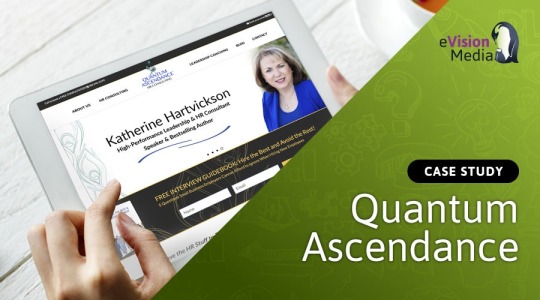
If there’s one client we’ve worked with who best exemplifies the benefits of offering great customer service, it would have to be Katherine Hartvickson of Quantum Ascendance.
Over the years, we’ve helped her build her business and provided a plethora of marketing services for her, and she’s shown her gratitude by remaining a loyal client and giving us a ton of referrals.
So, if you want to learn more about how we’re able to retain clients, build great relationships with them, and consistently keep them happy, then you’re going to want to read this case study.
Keep reading here.
Our Top Client Retention Strategies to Help You Deal With Difficult Clients
Difficult clients may test your patience, push your boundaries, and even make you question whether it’s worth maintaining a professional relationship with them.
But aside from the most extreme examples, it’s almost always beneficial to bite the bullet and continue to keep them as a client.
Because no matter how rude or unreasonable someone might be, and whether you’re in the right or not, how you respond to clients’ concerns is a direct reflection of your brand positioning and not something to be taken lightly.
Unfortunately, one bad interaction with the wrong client can deal a serious blow to the way your brand’s been positioned, as they may try to ruin your reputation by leaving bad reviews or bad mouthing you to other business owners.
That being said, learning how to deal with these situations in the best possible way is absolutely integral to your brand positioning and the long-term viability of your business.
With that in mind, below I’ve offered our top tips for how to retain clients and deal with the difficult ones like a pro.
1) Active Listening
No matter what kind of client you’re dealing with, it’s important to actively listen to them, giving them your full attention.
Make sure to let them express their concerns (no matter how nonsensical they might be), and ask clarifying questions to ensure you understand their issues.
This is even more crucial when dealing with difficult clients, who may be very suspicious of you and just waiting to point out something they think you’ve done wrong.
2) Act With Empathy
Regardless of whether they’re difficult, or an absolute darling, you should always try to put yourself in the client’s shoes and acknowledge their feelings and frustrations, expressing empathy to show that you genuinely care about their concerns.
Oftentimes, we let our egos get in the way of things, rather than focusing on what’s truly important, and when we allow this to affect relationships with clients, this is when things can go awry very quickly.
I can’t tell you how many times a potential issue has been resolved simply by acting with empathy and doing my best to understand things from the client’s perspective.
3) Stay Calm and Professional
When faced with challenging situations or difficult clients, you should always maintain a calm and professional demeanour.
I know it’s tempting to rip into a client who’s disrespecting you or causing problems, but no matter how right you may be, there’s just nothing to be gained from doing that.
So, whether the interaction is taking place in person, over Zoom, or via text (as in the case of a negative review or social media comment) make sure to avoid becoming defensive, rude, or confrontational.
4) Set Clear Expectations
This is especially important in our industry, as many clients don’t know a thing about marketing, and as a result, they tend to have ridiculous expectations about the kind of return they’ll get from investing in our services.
But if you address these kinds of knowledge gaps, challenges, and limitations right from the get-go, it can help to minimize misunderstandings and prevent potential problems.
With that in mind, make sure to clearly communicate what clients can expect from your services as soon as possible, and avoid making any claims that can’t be confirmed or aren’t fully accurate.
5) Effective Communication
One of the best things you can do to improve client retention and mitigate any issues with difficult clients is to keep them informed about the progress of their projects or the resolution of their issues.
Regular updates and open lines of communication build trust, so make sure to keep clients up to date on whatever you’re doing for them and let them know you care about the experience they’re having.
Even if there’s nothing to report, checking in every now and then and asking them for feedback can help you build credibility, improve your services, and do wonders for your brand positioning.
6) Customized Solutions
One of the ways that businesses tend to lose clients, and get stuck in the weeds with difficult clients, is by being too rigid and putting the needs of the business ahead of clients’ needs.
Now, obviously, there are reasons why you do things the way you do, and that may be much more convenient for you, but it’s also important to recognize that each client is unique.
More importantly, they don’t care about your processes and procedures, and being flexible goes a long way toward satisfying clients, so whenever possible, try to tailor your services to clients’ preferences.
For example, when working with clients, we typically use Google Drive, but for whatever reason, some of them can’t stand that platform. So, instead of arguing with them about it, we simply ask them what they would prefer and do our best to accommodate.
7) Keep It Simple
People don’t like jumping through hoops, especially when they’re paying for your services.
That being said, if you want to retain more clients and make it easier to deal with the difficult ones, you have to keep things as simple as possible.
For example, if navigating your website is too convoluted, a potential client may not even want to book a consultation because they don’t want to be bothered figuring out how to do that.
So, make sure to do whatever you can to make things easy for clients (and potential clients), and ensure that every interaction they have with your brand is seamless and straightforward.
8) Transparency
Having a lack of transparency is one of the best ways to ruin your relationship with a client.
So, make sure to be completely honest about your pricing, processes, and any potential delays, and if a mistake occurs, promptly acknowledge it, offer a sincere apology, and take immediate action to rectify the situation.
Demonstrating accountability and honesty can strengthen the trust clients have in you, and they’ll appreciate your transparency, especially when challenges arise.
9) Underpromise and Overdeliver
Another great strategy for retaining clients, and making it easier to deal with the difficult ones is to underpromise and overdeliver.
Make sure to promise only what you can reliably deliver, and then do whatever you can to go the extra mile, exceed those expectations, and provide exceptional service.
This will help to temper clients’ expectations and is especially effective for dealing with difficult clients, who will have less to complain about and be happy they’re getting more than they thought they would.
10) Train Your Employees
Whenever a client interacts with your brand, whether it’s browsing your website, speaking to you directly, or dealing with an employee, they’re experiencing your brand positioning.
And even a small misunderstanding between a client and one of your employees can completely destroy their perception of your brand.
So, if your employees deal directly with clients, make sure to train them on what to do when handling difficult clients, and don’t allow employees who aren’t quite ready for it to deal with clients directly.
11) Have Patience
Obviously, having patience will help you to deal with some of the more demanding or annoying clients, and avoid situations where you can end up damaging your brand.
But it’s also important to understand that some clients may require a lot more time than others to actually trust you, and if you’re not patient with them, they may never come around.
So, if you want to retain more clients, and make it easier to deal with the difficult ones, try to let things go, give them the benefit of the doubt whenever possible, and do whatever you can to show your commitment to nurturing a long-term relationship with them.
12) When All Else Fails, Let Them Go
As I already mentioned, it���s usually better to continue working with clients, even when they are difficult, but there are also times when it makes more sense to just let them go.
That being said, if you’ve employed all the strategies above, or even most of them, and you still haven’t built trust with a client, and are continuing to deal with a tense relationship, then it’s probably time to consider letting them go.
Often there are things going on with them that we don’t know about and there’s just nothing we can do to make the relationship better.
So, for the sake of your sanity, and that of your team, remember that there are times when it’s best for everyone to go their own separate ways.
Are you having trouble retaining clients or dealing with difficult ones? Why not book a free 30-minute consultation with me to find out how we can help?
To your business success,
Susan Friesen
P.S. If you liked the article, you might want to subscribe to our newsletter. We publish tons of valuable content to help you learn more about marketing, and subscribing is the best way to ensure you don’t miss out. Additionally, if you’d like to learn more about building a search engine-optimized website, click here for our free website guide.
0 notes
Text
Nurturing Your Practice: A Guide to Marketing for Therapists

As a therapist or clinical counsellor, it can be tough to make yourself stand out amongst the plurality of professionals with whom you’re competing.
All things considered, marketing for therapists can actually be a pretty difficult endeavour, not least here in Canada, where therapists are forced to adhere to some pretty strict guidelines.
However, in spite of these challenges, we’ve worked with several Canadian clinical counsellors, helping them to connect with clients, build their brands, and market their businesses, even while working within the rigid confines of these ethical and professional standards.
But if you’re a clinical counsellor who’s trying to wrap your mind around marketing, it can quickly become incredibly overwhelming, especially when you have limited knowledge of marketing.
So let’s discuss some of the problems you might encounter while staying within the guidelines you’re expected to follow.
This article focuses on the Canadian counselling industry, but these insights may also apply to you if your practice is outside of Canada.
If you’re looking for marketing tips for counsellors, or just trying to figure out where to begin when it comes to marketing your practice, then this article is for you.
The Challenges of Marketing for Therapists
Clinical counsellors in Canada are expected to adhere to high ethical and professional standards of practice, as outlined by provincial regulatory bodies, and professional organizations like the Canadian Counselling and Psychotherapy Association (CCPA).
While these standards are essential for ensuring the well-being and safety of clients, they can pose challenges for counsellors in terms of their marketing efforts.
Here’s how these standards may have an impact on marketing for therapists:
Confidentiality and Privacy
Strict confidentiality is expected to be maintained by counsellors when it comes to client information. This can make marketing difficult because counsellors cannot use client testimonials or case studies without explicit written consent, limiting their ability to showcase success stories.
And as we’ve learned from some of the counsellors with whom we’ve worked, they’re often uncomfortable even asking their clients about testimonials, as they fear it may be taken the wrong way, or in some way violate the standards of confidentiality and privacy that they’re expected to follow.
Informed Consent
Counsellors must obtain informed consent from clients before providing any services. This means that marketing materials must clearly communicate what clients can expect from counselling, which can be challenging to do without making unrealistic promises.
As a result, the clinical counsellors we’ve worked with have been very picky about the language we use to describe what they can do for potential clients, as they’re worried about saying something that might violate this guideline.
Advertising Standards
Professional organizations often have guidelines for advertising that restrict the use of superlatives, unsubstantiated claims, or guarantees of outcomes. This can severely limit the types of marketing messages counsellors can use and typically calls for some very careful and creative wording.
Cultural Competence
Counsellors must be culturally competent and sensitive to diversity, and this is especially true in a country with as diverse a population as Canada. Marketing materials need to reflect this sensitivity and inclusivity, which requires careful consideration of things like language and imagery.
Professional Boundaries
Maintaining appropriate professional boundaries with clients is crucial. So, when it comes to their marketing, counsellors need to be cautious not to blur these boundaries by becoming overly familiar or using marketing tactics that may seem overly intrusive.
Anti-Stigmatization
Counsellors are encouraged to promote mental health awareness and combat stigma. While this is essential, it can make marketing difficult, as counsellors must strike a balance between advertising their services and not contributing to the stigmatization of mental health issues.
Avoiding Dual Relationships
To avoid conflicts of interest, counsellors are advised to avoid dual relationships with clients, which means not making friends with clients or otherwise engaging with them in non-professional capacities. This can make marketing for therapists within small communities or among personal networks much more challenging.
Professional Ethics
Counsellors must adhere to a strict code of ethics, including principles like beneficence, non-maleficence, and respect for autonomy. That being said, marketing for therapists should align with these ethical principles and not compromise client welfare for the sake of promotion.
Now, to be absolutely clear, the preceding points are meant to simply be statements of fact, and in no way am I trying to disparage or criticize these standards, which are obviously there for good reason.
Adherence to these standards is essential for maintaining the integrity and professionalism of clinical counsellors in Canada, but navigating these guidelines to ensure marketing efforts are ethical, accurate, and respectful of clients’ needs and rights can definitely make marketing for counsellors more difficult.
With that in mind, let’s explore how you can stay within these standards, as they relate to several forms of marketing for therapists.
Read: How Brand Positioning Transformed a Counselling Business into a Market Leader

When you’re trying to figure out how to do something, it always helps to look at examples of how other people have done it and model your efforts after what’s already been effective.
This case study details everything we did for our client, TalkOnline Counselling, including their logo, website, content marketing, social media marketing, and more.
So, if you want to learn about branding and marketing for therapists by looking at an example of what we’ve done for one of our clients, then this case study is a must-read.
Read more here.
Our Top Tips on Marketing for Therapists
After working with several clinical counsellors, I’ve learned first-hand how tricky it can be to come up with effective marketing for therapists.
But it’s not as difficult as you might think, especially for someone who’s already familiar with the standards they’re expected to follow, and with a little creativity, and some careful consideration, you can successfully market your counselling business.
That being said, let’s look at how you can effectively market your therapy practice using several common strategies.
SEO and SEM
Therapists and clinical counsellors can ethically use SEO and SEM strategies to market their services effectively online while also upholding professional standards.
When it comes to search engine optimization, make sure to use ethical SEO techniques that prioritize accuracy and transparency. Use relevant keywords, meta descriptions, and valuable content to improve search engine rankings without exaggerating anything or making any claims that would be considered unethical.
Also, don’t forget to optimize your online presence for local searches, using location-specific keywords and making sure to provide accurate business information, which can be essential for attracting local clients and maintaining their trust.
As for the search engine marketing side of things, when running ads on search engines like Google, make sure to meticulously adhere to the ethical advertising guidelines set by provincial regulators and professional associations, and refrain from using sensational language or making exaggerated claims.
Website Design and Development
No matter what kind of business you own, if you want your marketing efforts to be effective, you’ve got to have a website that looks great, functions properly, and provides a great experience for users, and the same holds true for therapists and clinical counsellors. Here are some ways you can go about doing that:
Ethical Content: Create accurate, evidence-based content, and avoid making any exaggerated claims about the effectiveness of your counselling.
Informed Consent: Clearly explain your counselling processes and potential outcomes on your website to build trust and help clients make more informed decisions.
Client Confidentiality: Prioritize client confidentiality and privacy. Do not share personal client stories or testimonials without explicit consent, and even if you do get a client’s consent, make sure to remove any identifying details.
Professionalism: Make sure to maintain professional boundaries on your website, refraining from personal interactions with clients and clearly stating your professional identity.
Ethical SEO: Use ethical SEO techniques for better visibility, avoiding misleading tactics and ensuring accurate meta descriptions, keywords, and content that’s directly relevant to what you do and provides value for users. And don’t forget to optimize for local search, as well.
User-Centric Design: Ensure that your website prioritizes the experience of users by making it easy for potential clients to get in touch with you and find essential information. It’s also a good idea to create an FAQ page on your website that addresses common questions about counselling and your practice in particular.
Privacy and Security: Implement strong privacy and security measures to protect client data and maintain trust.
Online Booking: Offering convenient online appointment booking through your website is essential, but make sure that it respects client privacy and is as secure as possible.
Social Media Marketing
Social media is one of the best marketing tools for any business owner, but standards of practice can make it considerably trickier for therapists and clinical counsellors.
Here are some tips for effectively and ethically marketing your counselling business on social media:
Educational Content: When it comes to marketing for therapists, one of the best ways to use social media is by providing educational content that can help users and display your expertise. But try to focus on general mental health and well-being information, and avoid giving personal advice or diagnoses.
Awareness and Stigma Reduction: Doing what you can to raise awareness and reduce stigma surrounding mental health issues is another great content strategy for social media. One of the ways to do this is by creating informative posts that explore relevant statistics and discuss common mental health issues.
Client Testimonials: If you’re comfortable with doing this, and absolutely sure it adheres to the ethical guidelines you’re expected to follow, highlighting client success stories is one of the best ways for you to build trust and credibility on social media. But make sure to get written consent and avoid disclosing any identifying information.
Sharing Tools and Resources: Another great way to leverage social media as a clinical counsellor is by providing links to reputable resources and organizations, and sharing tools and techniques that potential clients can use to improve their mental health and well-being.
Ethical Advertising: If you’re going to run paid ads on social media, make sure to stringently adhere to all the relevant standards of practice, like avoiding misleading and sensational language.
Content Marketing
If you’re a therapist or clinical counsellor, content marketing offers one of the best ways to showcase your expertise and unique approach, which can help to build trust and credibility with potential clients.
With that in mind, here are some tips to help you make the most of your content marketing:
Educational Blog Posts: Creating a blog on your website gives you the opportunity to share informative articles about mental health topics, coping strategies, and self-care. But make sure to always cite credible sources and avoid offering personalized advice.
E-books and Guides: Another great content marketing strategy for counsellors is to develop e-books or downloadable guides on mental health-related subjects. These can serve as valuable resources for your audience, and they can also help you build up a list of subscribers.
Webinars and Workshops: Hosting webinars or virtual workshops on relevant topics is an excellent way to connect with potential clients, but you’ve got to ensure that these sessions are educational, rather than therapeutic, and do not constitute a client-counsellor relationship.
Social Media Sharing: Regardless of what kind of content you’re creating, whether it’s blog posts, e-books, or webinars, make sure to share this stuff on your social media accounts for even greater engagement.
Client Success Stories: With all the regulations regarding privacy and confidentiality that counsellors are expected to follow, this can be a tough one to pull off. But if you can get explicit written consent and ensure content is anonymized, these kinds of case studies offer one of the most effective ways to show what you’re capable of doing for clients.
Newsletters: Sending out regular newsletters is an excellent way to distribute any content you’ve been creating, while maintaining relevancy and familiarity with your audience. They also give you the chance to provide additional resources and educational content for your subscribers.
Podcasts: I know everyone and their dog has a podcast these days, but it’s one of the most popular entertainment mediums today, so if you think you can handle the work it requires, you should consider starting a podcast where you discuss mental health topics with experts and share information. But make sure to include a disclaimer clearly stating that listening to your podcast is not a substitute for therapy.
Guest Blogging: Contributing guest articles is an effective way of extending the reach of your content and expanding awareness of your business. Not only does this allow you to showcase your expertise by offering valuable insights, but it may also give you the chance to link back to your website from popular publications.
Are you having a hard time figuring out how to market your counselling business? We’ve helped many counsellors build their brands and market their businesses. Contact us today to find out more about what we can do for you.
To your business success,
Susan Friesen
0 notes
Text
How the Right Brand Positioning Helped a Card Collector Create the Business He’s Always Wanted

A Case Study on Jackpot Sports Cards
Since eVision Media was founded over 20 years ago, we’ve worked with hundreds of clients across a vast array of industries, including everything from counsellors, consultants, and coaches to lawyers, interior designers, authors, and more.
And after working with so many different kinds of clients to help define their brand positioning and build their businesses, I’ve realized that what I enjoy most is working with visionaries.
I know there are many different ways to define this term, but in my experience, visionaries are incredibly imaginative, creative, and wise individuals who have a grand vision of what they’d like their businesses to be.
But as I’ve found out over the years, despite the fact that these people have amazing visions, they often lack the time, resources, or knowledge that’s required to actually bring these ideas into reality. What’s more, they’re often not very detail-orientated, which can make it challenging to bring their visions to fruition.
At the same time, because they love to be in creation mode, they often end up with a million and one things on their to-do lists, which keep getting longer and longer with every new idea that comes to mind.
I’m proud to be able to provide them with a detailed “strategy and fulfillment” service that allows us to relieve this burden and take the reins while these clients get back to doing what they do best.
That being said, if there’s one client we’ve worked with who best exemplifies this visionary mindset, it would have to be Chad Davis of Jackpot Sports Cards.
When we started working with Chad, he wanted to participate in everything we were doing for him, but eventually, he relented, as I explained to him that the whole point of hiring us is so he can take all that work off his plate and let us do it for him.
As a result of this more hands-off approach, Chad has been able to focus on things that bring him joy and benefit his business, like going to conventions and trade shows, updating his inventory, and making sure his prices always reflect the current market.
As with most of us business owners, life often gets in the way of fulfilling our vision, and Chad is no exception to that rule, as he’s had to deal with several of life’s ups and downs since we started working with him. Luckily for Chad, we’ve been there to help keep his business going, no matter what it is he’s dealing with.
So, if you want to learn more about how we help clients like Chad to create visionary branding, or you just want to have a better understanding of brand positioning, then you’re going to want to keep reading.
READ: Crafting a Unique Selling Proposition: Unleashing the Power of Your Brand
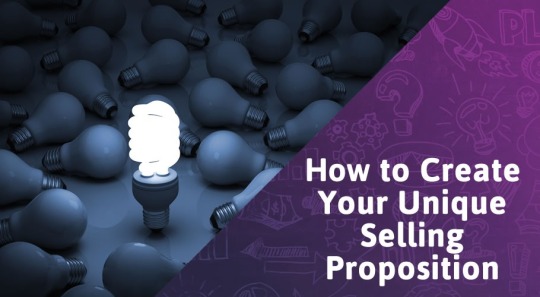
No matter what kind of business you own, one of the most important aspects of your brand positioning is your unique selling proposition, otherwise known as your USP.
This aspect of your branding helps to communicate to potential customers why they should give their business to you, instead of one of your competitors.
So, if you’re looking to define your USP, but don’t know where to begin, then this article is for you.
It explains what a USP is, how it will benefit your brand, and how you can create one of your own.
Keep reading here.
How 5 Brand Positioning Strategies Brought Chad’s Vision to Fruition
When Chad first came to us, he was basically running things out of his garage, or anywhere else he could store the massive number of trading cards he’s amassed since childhood, and selling his collectibles through platforms like eBay and Facebook.
He didn’t have a website, logo, or any branding to speak of, so back in 2021, he signed up for our VIP Branding, Website and Marketing Package, which includes brand consulting with me, logo and brand design, website design and development, along with six months of SEO, SEM, content marketing, and social media marketing, and he’s been with us ever since.
The following five points explain what we’ve done for Chad over the last couple of years, and how we’ve leveraged brand positioning to turn Jackpot Sports Cards into one of the most well-known and respected brands in the trading card industry.
Website
Believe it or not, in the trading card business, there are a lot of brands out there with websites that look like something that was developed 15 years ago.
Clearly, the main focus is on the cards, and these kinds of marketing and branding considerations seem to go by the wayside.
Chad knew he didn’t want to follow suit, and right off the bat, he had a cohesive vision of how he wanted his brand to be portrayed, not least when it came to his website.
Chad has a monstrous collection of trading cards, with some items going for tens of thousands of dollars, so he wanted his website to be perceived as professional, authoritative, sophisticated, and something that appeals to people who are willing to spend this kind of money on card collecting.
So, as you can see, we made sure every single aspect of his website reflects this brand positioning, helping him to build trust and credibility with customers by keeping the design very minimal, with clean lines, and a simple, black-and-white colour scheme that exudes elegance, expertise, and authenticity.

We also worked with Chad to ensure that all of the imagery on his site is of the highest possible quality. Having high-quality imagery not only entices potential customers, but also benefits his brand positioning, as it positions Jackpot Sports Cards as being more sophisticated, high-end, and professional.
As you can see, the images of the products are crystal clear, allowing collectors and investors to see the condition of each item, and confirm that what they’re looking at is exactly what they will receive.

What’s more, we also did what we could to build trust and credibility through the copy on Chad’s website, with his About page being the best example of this.
Up above the fold, it plays up Jackpot’s USP, explaining that Chad strives to “demonstrate ethics of the utmost integrity” while providing “the best possible experience” for customers, and guaranteeing that he will “meticulously package and protect your product with unmatched precision,” which is very important, as Chad is renowned for having some of the best shipping practices in the business.
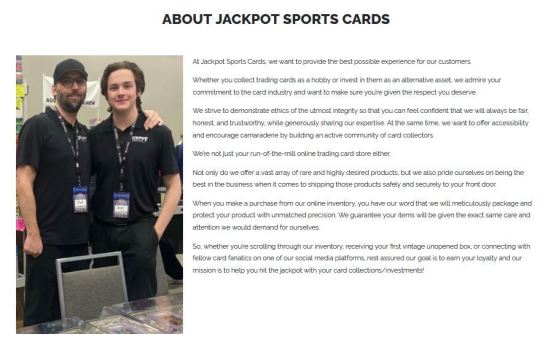
Then Chad tells the heartwarming story of how he got into card collecting at the age of nine, before explaining how he and his father ran a card shop for several years when he was in elementary school.
It’s a subtle little touch, but this kind of story really helps to build Chad’s reputation as an authority in the trading card industry, as he’s had a passion for this hobby for such a long time, and has been in this business off and on since he was a kid.
As we always do for our VIP clients, we also SEO-optimized Chad’s website, including the most appropriate keywords in his website content, while ensuring his website is mobile-friendly and responsive, so it looks great and functions properly no matter how it’s accessed.
We’ve also used SEM tactics, and continue to do so, such as running Google Ads to drive additional traffic to Chad’s website from the search engines and elsewhere.
Online Store
From our first meeting with Chad, he was adamant about having his own online store and was sick of selling his products on other people’s platforms. He wanted to be able to make all of his sales, from start to finish, on his own website.
So, we built him an online store using WooCommerce that not only looks great but allows Chad to take care of every purchase in one centralized location.
As you can see, his store features the same high-quality product images found throughout Chad’s website, and it offers an intuitive interface that allows customers to search for products, leave reviews, share products on social media, sort or categorize them based on a number of different factors, and receive emails to remind them that they’ve abandoned their carts or when their orders have shipped.

Chad’s shopping cart system allows him to process payments, offer discounts or gift cards, add an unlimited number of products to his inventory, and it also includes built-in tax and shipping calculators.
In addition, each product is given an SEO-friendly URL, allowing it to be easily indexed by search engines.
We’ve also worked with Chad to teach him how to upload new products and update his store himself, making the process as simple as possible.
Logo
Jackpot Sports Cards’ logo features the same slick, clean, and professional-looking aesthetics that can be found throughout Chad’s website and the rest of his branding.
At the same time, we wanted it to stand out as much as possible, and not fade into the background, while maintaining the same feel as all of his other branding.
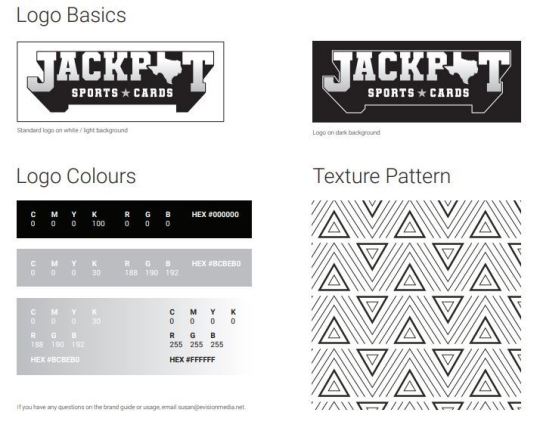
As you can see, we did this by giving his logo some prominent depth and dimension, making it look like it’s towering over everything, including Chad’s competitors.
Being the proud Texan that he is, Chad also made a point of having us include some Texas-themed imagery in his logo, including the Lone Star and the shape of the state of Texas to replace the “O” in Jackpot.
This not only appeals to potential customers in Chad’s area, but also helps him to further differentiate himself from his competitors, and build trust by showcasing his patriotism.
Social Media
Aside from showcasing Jackpot’s products, we’ve used social media to help solidify Chad’s brand positioning as a trusted professional in the trading card industry.
For instance, as you can see below, we created branded imagery for all of Chad’s social media accounts, to ensure the same sophisticated look is reflected in all of his branding, across every platform.


As you can tell from the small sampling of posts below, we’ve also worked with Chad to create some pretty amazing content and kept things consistent by ensuring that we only use the same high-quality imagery you’ll find on Chad’s website and including his logo on as many posts as possible.

In addition to featuring new products, as they enter Chad’s inventory, we also post snippets from Chad’s blog, tips for collectors, testimonials from customers and industry heavyweights, glimpses of what goes on behind the scenes, and we’ve even helped him live stream from a couple of conventions.
All of this helps to cement Chad’s brand positioning as an authority in this industry who can be trusted, knows his stuff, and has a collection of some of the best products in the business.
Content Marketing
Last but certainly not least, there is the content marketing we’ve been doing for Chad, which offers yet another opportunity to highlight Jackpot Sports Cards’ brand positioning.
On his blog, affectionately known as Chad’s Card Vault, we work with Chad to build upon his brand positioning by providing valuable content that explores what Jackpot Sports Cards is all about and offers some of his expertise.
This includes things like stories from Chad and his dad’s old card shop, musings about featured trading cards, recaps from the conventions Chad attends, tips for collectors who are just starting out, and more.
But if I had to choose a blog that I believe has had the best effect on Chad’s brand positioning, I’d have to go with Protecting Precious Cargo: How to Ship Trading Cards Like a Pro.
As you can see from the image below, this article offers an incredibly detailed step-by-step guide on Chad’s shipping process, which is basically the best in the business, and details some of the horrible experiences Chad has had with other people’s shipping practices.

This meticulous shipping process is one of the main pillars of Chad’s brand positioning, so it was important for us to highlight his shipping practices in this way.
Not only does this draw attention to one of the main tenets of Chad’s unique selling proposition, but it also provides highly valuable content for anyone looking to ship trading cards and allows Chad to call out his competitors’ lacklustre shipping practices without even saying a word about them.
Besides Chad’s blog, we also publish a monthly newsletter for him, using the same branded imagery you’ll find across all of Chad’s marketing.
These newsletters provide a great way for Chad to distribute his monthly blog content, entice subscribers to visit his store and social media channels, and promote special offers and upcoming appearances at conventions and trade shows.
Do you need help defining your brand positioning? We’ve been helping business owners to build their brands for more than 20 years. Contact us today to find out more about how we can help.
To your business success,
Susan Friesen
P.S. If you liked the article, you might want to subscribe to our newsletter. We publish tons of valuable content to help you learn more about marketing, and subscribing is the best way to ensure you don’t miss out. Additionally, if you’d like to learn more about building a search engine optimized website, click here for our free website guide.
5 notes
·
View notes
Text
Navigating the Marketing Maze: How to Choose the Right Marketing Agency and Avoid Getting Burned by a Bad One

I hate to admit it, but the marketing industry has a bad reputation.
To be fair, if you know how to choose the right marketing agency, they can be the difference between whether your business soars to new heights or struggles to get off the ground.
But if you end up choosing the wrong one, they can be an unproductive money pit of people who don’t know what they’re doing, who’ll put you in a worse place than you were before you hired them.
For example, one of our clients had an absolute horror show to deal with from the marketing company they chose to work with before us.
This company reached out and offered to build their website but soon after, they found out the head of this marketing company had been involved in something highly illegal, and was incarcerated.
Unfortunately, their domain was under the agency’s name, and as a result, their website was shut down. They then ended up going through a nightmarish situation that ended with having to hire us to rebuild their website from scratch.
Admittedly, this is a pretty extreme example, and I know each industry is going to have its fair share of unscrupulous players, so I’m not saying that the world of marketing has a worse reputation for hucksterism than any other industry.
In fact, much of this negative perception of the marketing industry comes as a result of people’s lack of understanding, and failure to know what to expect given their budget.
But after hearing so many horror stories from our clients and others who feel they’ve been ripped off by a marketing company, I want to offer some advice to business owners like you, in the hopes that you’ll be a bit savvier in this respect.
So, if you want to learn how to choose the right marketing agency for your business, how to avoid the wrong ones, and how to have more realistic expectations, then you’re going to want to keep reading.
READ: How to Choose a Developer for Your Small Business Website

Any marketing company that’s worth its salt will be able to develop a website for you.
But you can choose to hire a single developer to create your website, instead of an entire marketing company, if you’d prefer.
However, just like hiring a marketing company, when you’re hiring a developer, you need to know what to look for and what to avoid.
With that in mind, this article offers several pieces of advice on how to choose the right website developer, so you can make the right choice the first time.
Keep reading here.
How to Choose the Right Marketing Agency
Before I cover what makes a good marketing agency, it’s important to point out that knowing how to choose the right marketing agency has a lot to do with your budget and the nature of your business.
I mean, let’s be honest, just because a marketing agency does great work doesn’t mean they’re going to be the right one for you.
There are tons of incredible marketing companies out there, with massive teams, doing amazing work, but typically, these kinds of agencies only work with big corporate clients, as that is the kind of money it takes to pay for that kind of work to be done.
That’s not to say that smaller, boutique marketing companies can’t do amazing work, as well, but it’s important to be realistic about what’s actually right for you, rather than trying to pick the most high-profile marketing agency, which you may not be able to afford anyway.
So, before you start to consider your various options, make sure to have a firm grasp on what your business objectives are, what your marketing budget is, and what the companies you’re considering are going to charge you for their services.
With that said, let’s look at some of the qualities of a great marketing company, particularly those that you can verify yourself before hiring anyone.
Proven Track Record
Any reputable agency should have a lengthy portfolio showcasing their past work, successes, and case studies that demonstrate their ability to achieve tangible results for clients.
That being said, if you’re considering hiring an agency that doesn’t have any kind of portfolio or is hesitant about showing you past work, this is a major red flag, and you should probably move on.
Client References and Testimonials
Another way to vet a potential agency’s track record is by reading testimonials from their clients, looking at the websites or other marketing assets they created for those clients, and even reaching out to those clients to ask them what their experience with the agency was like.
At the very least, any good marketing company should have a list of testimonials from satisfied clients, and they should be able to put you in touch with some of them, as well. If they’re not comfortable with you asking them about this or refuse to do so, it may be a sign of bad things to come.
Expertise and Specialization
Another thing to consider, if you want to pick the best marketing company for your business, is to look for an agency that specializes in your industry or has expertise in the specific type of marketing you need, whether it’s digital, content, social media, or traditional marketing.
That’s not to say that a more all-purpose agency can’t provide great results, but hiring an agency that’s already well-versed in your industry or the kind of marketing you’re looking for certainly can’t hurt.
Strategic Approach
Any good agency should be able to formulate a well-defined marketing strategy that aligns with your business goals and target audience, rather than relying on generic tactics.
With that in mind, if you ask a potential marketing agency for a proposal, and they’re suggesting lacklustre strategies, tactics that aren’t aligned with your business objectives, or things that just seem straight out of left field, you might want to reconsider.
Clear Communication
Hands down, this is one of the most important things to consider when choosing a marketing company.
Effective communication is crucial for a successful partnership, and effective marketing, so a great agency should be transparent, responsive, and able to explain complex concepts in a way that’s understandable to you.
So, if they’re unresponsive or hard to get a hold of before you’ve even hired them, or you feel like you’re being bamboozled when they try to explain things to you, then you can expect this to continue after you’ve hired them, and they’re probably not the best choice for you.
Strong Online Presence
This is one of those dead giveaways that just can’t be ignored when you’re in the process of vetting potential marketing companies.
I cannot stress this enough: Before you even consider hiring a marketing company, make sure to look at their online presence. When you check out their website, social media accounts, and anything else you can find, everything should look professional and consistent.
Because if they can’t even get their own brand positioning right, then you can expect pretty much the same results when they start working on your marketing.
Good Reputation
This one can be a bit tough to confirm for yourself, but with all the review sites, Google reviews, and everything else out there, it shouldn’t be too difficult.
With that said, make sure to find as many reviews as possible on any marketing agency you’re thinking about hiring, and spend a considerable amount of time scrutinizing them.
Regardless of how many reviews they have, and even if they have five stars, make sure to go straight to the bad reviews first. Remember, companies can pay for fake five-star reviews, but they’re never going to pay for the bad ones.
Make sure to read through all of them, and if anything gives you a gut feeling that something is wrong, especially if reviewers keep citing the same issues, then this is an obvious red flag.
How to Manage Your Expectations
Now that we’ve gone over some qualities that you’ll find in any great marketing company, which you can verify for yourself, let’s talk about how to manage your expectations when picking a marketing company.
As I said above, a lot of the marketing industry’s bad reputation comes from the fact that people don’t understand it, or have completely unreasonable expectations.
For example, you shouldn’t be thinking you’re going to make 100 sales from a $50 ad. Everything is relative – the more of an ad budget you have, the higher return you can anticipate.
In saying that, if you want to choose the best marketing company for your business, you definitely shouldn’t make your choice based on price alone, unless you’re willing to accept the drawbacks of that decision.
If you choose a marketing agency with the lowest price, beware of their level of experience and expertise in the industry, as the old adage, “You get what you pay for,” comes into play here.
At the same time, there are many business owners out there who can’t afford to hire a marketing agency or don’t want to pay for one, so they’ll opt for a virtual assistant (VA) instead.
You can save a lot of money by hiring a VA, as opposed to a marketing agency, but again, you have to manage your expectations.
Typically, virtual assistants will charge a very small amount because they have little to no experience.
It’s also not uncommon to hear about someone becoming a VA when their marketing or web design business failed. For example, with the little bit of experience they got from that, they may have found out how to build a basic website by simply downloading themes, and they’re doing that as a VA now.
At the end of the day, a VA is basically a support system for their clients, and when you have that frame of mind, you just want to please everyone, and as a result, many of these people just can’t say no, even when they don’t actually know what they’re doing.
For example, you may hire a VA to build you a website, and even though they don’t know how to do that, they’ll just go and look up a YouTube tutorial to figure out how to do it, but typically, the results aren’t great, and you shouldn’t expect them to be.
All things considered, if you do choose to hire a VA for your marketing, you should be prepared to tell them exactly what needs to be done.
You’ll have to do the strategy, write and design the copy and campaign, and then just hand it over to the VA to put everything together.
Whatever you choose to do, make sure to thoroughly vet any marketing agency you’re thinking of hiring, and regardless of whom you choose to hire, be sure to manage your expectations in terms of what kind of return you’re going to get given the budget you have.
I’m a firm believer that if you invest in your business wisely by choosing a marketing agency that knows your brand positioning and understands your vision and goals, you will have a greater chance at seeing a return on that investment, and much quicker, too.
Are you looking for one of the best boutique marketing agencies in Canada? We’ve been helping business owners build their brands for more than 20 years. Contact us today to find out more about what we can do for you.
To your business success,
Susan Friesen
P.S. If you liked the article, you might want to subscribe to our newsletter. We publish tons of valuable content to help you learn more about marketing, and subscribing is the best way to ensure you don’t miss out. Additionally, if you’d like to learn more about building a search engine optimized website, click here for our free website guide.
0 notes